Home / Blog / Web Content / How to Create a Nonprofit Case Study [Template & Examples]


How to Create a Nonprofit Case Study [Template & Examples]
Show your impact. Show supporters how you help. Let supporters know how their donations and volunteer hours are making a difference. I know you’ve heard all of this a million times. And a nonprofit case study is one way to actually do it.
What Is a Nonprofit Case Study?
Similarly to your run-of-the-mill business or research case study, a nonprofit case study digs into a challenge and offers insight (most often in the form of data and analysis of that data) on how and why it has since improved based on specific things that your organization has done.
For example, a leadership-building nonprofit might create a case study around a leadership summer camp they offer and how those young leaders went on to improve the community because of the knowledge and skills they learned at camp.
They might even focus on a specific student that went through that program. If you decide to zoom in on one individual’s story for your case study, check out our post on case stories to get advice geared toward that specific approach.
Creating a Case Study
To create a nonprofit case study, you’ll need access to data surrounding your chosen issue and subject. That could include both outside resources from your community, like research studies or reports from other organizations, as well as your internal program or survey data.
If you don’t have the necessary knowledge or experience of the topic you’ve chosen for the nonprofit case study, plan to chat with someone who does and pick their brain about the topic and potential areas or clients to explore. Teamwork makes the dream work.
Choose a Subject
The goal of most nonprofit case studies is to demonstrate your impact. Think of your mission and vision.
- What progress have you made toward it?
- What program or service best demonstrates that progress?
- Is there a specific area or case that’s an exceptional example?
- Are there big picture statistics on your Impact page that you can dig into?
As you’re considering a topic, available data should play a role. Do you have the numbers to back your claims of an impact? Supporters will easily see through the holes in a case study that’s not backed by credible data. Case studies allow you to focus on the “show, don’t tell” approach and a lack of data will leave your argument and claims of an impact pretty flimsy.
Gather Data
Noting that you can access data is often easier than actually tracking down the numbers that you need. Circle up with team members involved in program and service logistics to find and understand the numbers for your case study topic.
This will likely also include some outside research on your part. Bring in data from reputable outside organizations to paint a background picture of the overall issue and challenge that your nonprofit faces. Going back to the leadership camp example, they might bring in statistics or studies about at-risk youth and the positive effects of mentoring.
Nonprofit Case Study Template
As you’re drafting your first nonprofit case study, a template can help you frame the study in an easy-to-digest way. While you might decide to make a few tweaks as you go, we’ve found this template to be a great foundation.
Provide Background Information
Paint a picture of your work and the community you work with.
- What are your organization’s mission and vision?
- Who do you serve? Why do they need help?
- What does the program or service in question do?
- Is there any other background information that would be helpful?
Detail the Challenge
Explain the issues that were faced from the outset of the project, program or service.
Explain Your Actions
- What specific actions did you take? Be sure to note why.
- How did you overcome the challenges you noted above?
- How do your actions work toward your mission and vision?
Note Positive Outcomes
Dive into the impact of your actions now that your readers and supporters have a solid understanding of the situation.
- How did the actions you took work to improve the previous state of your community?
- How has the future improved for your study subjects?
- Which elements of the program/service/project went well? How so?
Key Takeaways
- What did you learn?
- What surprised you about the results?
- What do your results say about the larger challenge/issue at hand?
Wrap up your nonprofit case study with a brief summary of the impact your organization achieved and any next steps for the program or service to work toward expanding that impact. This is also a great place to include a strong call to action to let readers know how they can help — whether that’s through donations, volunteering, spreading awareness or another action.
Examples of Nonprofit Case Studies
Before you jump into creating one of your own, check out a few other organizations who’ve done it well.

Habitat for Humanity East Bay/Silicon Valley, Social Impact Study
Habitat for Humanity East Bay/Silicon Valley created a social impact study to show the continual impact of a new home on their past clients’ lives. Using a survey conducted by a third party, they demonstrated health benefits, increased savings and higher graduation rates for kids.

Yellowstone to Yukon Conservation Initiative, Why Y2Y
Not all case studies are necessarily labeled as such. Yellowstone to Yukon Conservation Initiative uses the grizzly bear population as an indication for the health of natural land. On their “Why Y2Y” page , they laid out their challenge and solution in a compelling call to action to support their cause. To keep the study succinct, they link other pages on their site for additional information.

Rainforest Alliance, Community Forestry Studies
Rainforest Alliance conducted ten case studies , each in a different community and location, to show how their community-central model of forestry conservation can benefit both the communities and the forests. They end the page with a strong call to donate to help protect forests.
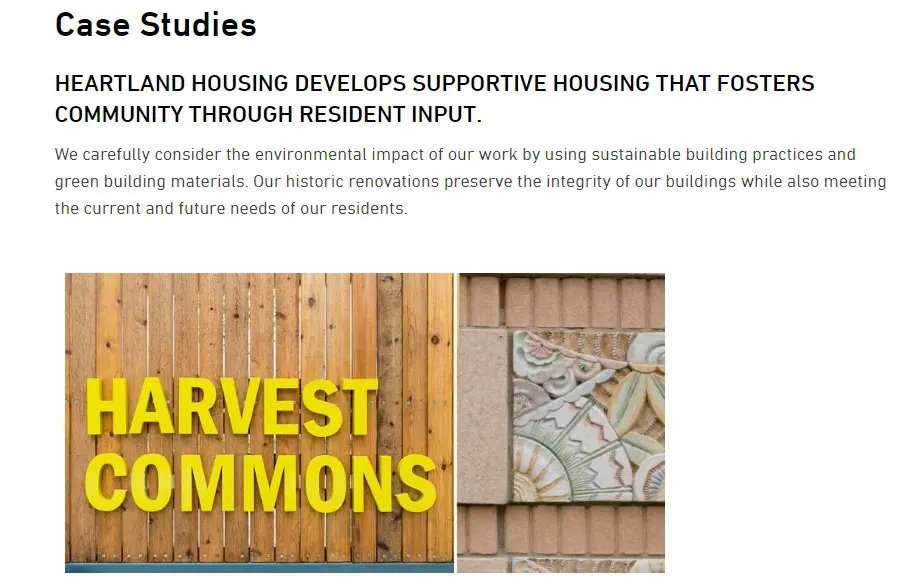
Heartland Alliance, Housing Case Studies
Through their housing development projects, Heartland Alliance Housing claims a comprehensive approach through partnerships with residents and the community. And with their Housing Case Studies , they’re able to actually show how those partnerships and considerations of a sustainable future benefit everyone.
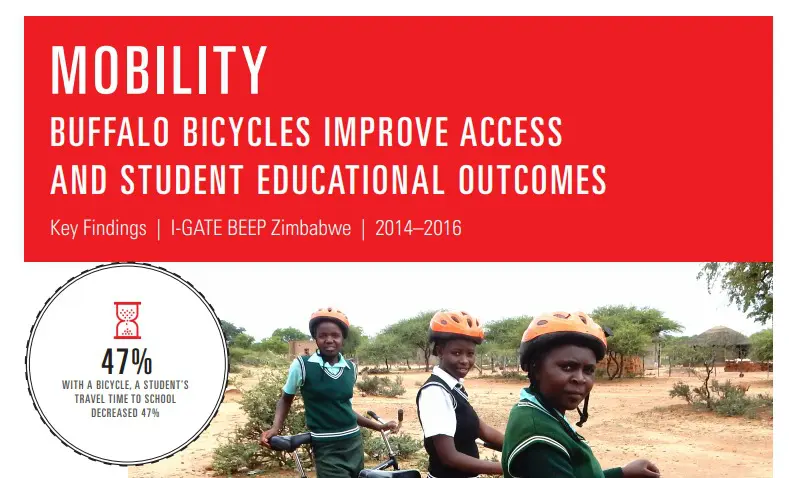
World Bicycle Relief, Key Findings
World Bicycle Relief dug into one of their programs to demonstrate their overall impact on improving access to education in developing countries. This case study on their Improving Girls’ Access through Transforming Education program clearly outlines the need, opportunity and impact, wrapping up with a push to support their overall organization.
Nonprofit case studies are a great tool for fundraising communications, annual reports, impact pages and awareness building. Once you put in the work to create one, you can use it in both online and print communications to encourage old and new supporters to become more involved with your organization.
Case studies allow you to back up your ask with real impact that you’ve accomplished.
Does your nonprofit have a compelling case study you’d like to share? How do you use it to move your marketing forward? I’d love to hear more and swap case studies in the comments.
You might also be interested in
21 examples of nonprofit websites with amazing content, case stories: how to create and use them in nonprofit marketing, 8 inspiring examples of nonprofit impact pages.
Very useful and interesting. Thank you
You are very welcome, Carmen. I’m glad you found it useful!
This is very helpful, I wish I could have someone for one on one help with writing one with such a passion!!!!!!
I’m so happy to hear that you found the post helpful, Celen! Let me know what questions come up as you piece together your case study. It can be tough to get started and track down the data you need, but we’ve seen organizations get some incredible results from showing off their impact in this way.
What are you looking for?

How to Write a Great Case Statement for Your Nonprofit + Examples

At some point, your nonprofit will need to make a case for why you exist, what you do, and how you do it. This is typically done through a case statement. But, what is a case statement and when do you need it? This article will help you understand the purpose of a case statement, how to write a great one, and provide examples for inspiration.
What Is a Case Statement?
A nonprofit case statement is used to make a compelling argument for why your nonprofit exists, what you do, and how you do it. It should be clear, concise, and persuasive. The case statement should be used to guide all of your communications, including website content, fundraising appeals, grant proposals , and more.
When Do You Need a Case Statement?
You will need a case statement when you are making a case for why your nonprofit exists, what you do, or how you do it. For example, you might use a case statement when:
– Asking for donations
– Applying for grants
– Writing website content
– Describing your nonprofit to others
Who is Your Target Audience?
Your target audience is anyone who needs or wants to know about your nonprofit, including donors, funders, volunteers, board members, and the general public. When writing your case statement, keep your target audience in mind and make sure that the language you use is appropriate for them.
How to Write a Great Case Statement
A great case statement will be clear, concise, and persuasive. Here are some tips for writing a great case statement:
– Have an emotional opening: Start with an emotional story that will make your audience care about your nonprofit.
– Explain the purpose of the organization: Make it clear what your nonprofit does and why it is important.
-State your mission and values: Include your nonprofit’s mission statement and values.
– Describe your programs and services: Include a brief description of your programs and services.
-Talk about the outcomes of those programs: What impact have your programs had on the people you serve?
-Make a case for why you need support: Explain what your nonprofit needs in order to continue doing its work.
-Include a call-to-action: Tell your audience what you want them to do, such as donate money or volunteer their time.
– Ask for a specific amount of money: Be specific about how much money you need and the need it will address.
– Offer to provide more information: Include your contact information and let people know that you are eager to answer any questions they might have.
Examples of Stand-Out Case Statements
Now that you know what a case statement is and how to write one, here are some examples of stand-out case statements to inspire you.
– Autism Society: The Autism Society’s case statement starts with a powerful story about a mother whose son has autism. It then explains the purpose of the organization and its programs. The statement ends with a call-to-action, asking for donations to help support the Autism Society.
– National Breast Cancer Foundation: The National Breast Cancer Foundation offers a case statement that begins with a quote from a breast cancer survivor. It then describes the organization’s mission and programs. The statement ends with an appeal for donations, asking people to help fund the fight against breast cancer.
– Make-A-Wish Foundation: The Make-A-Wish Foundation offers a case statement that starts with a quote from a child who benefitted from the organization’s work. It then goes on to explain the purpose of the organization and its programs. The statement ends with a call to action, asking people to donate money or time to help make wishes come true for children with life-threatening illnesses.
By following these tips and using these examples as inspiration, you can write a great case statement for your nonprofit that will convince people to support your cause.
- North America
- Search Search
- Arts & Culture
- Associations
- Environment & Animals
- Foundations
- Higher Education
- Human Services
- Primary & Secondary Education
- Campaign Planning & Feasibility Studies
- Campaign Management
- Data Analytics
- Systems & Change Management
- Audits & Assessments
- Interim Development Management
- Training & Leadership Development
- Strategic Planning
- Specialized Development Projects
- Board of Directors
- Executive Leadership
- Fundraising Fundamentals
- Articles & Publications
- Events & Webinars
- Case Studies
- Our Clients
Your Guide to Writing a Compelling Case for Support
January 30, 2024
BY: Claire Splain Bens, Vice President ; Vann Ellen Mitchell, Senior Vice President
The case for support provides the foundation for your entire campaign. An effective case can excite, compel, and inspire your donors to dream big and raise their philanthropic sights. In this article, we share some common mistakes made when writing a case for support in fundraising and steps to follow.
As organizations prepare for a campaign, they often face competing priorities and limited resources— drafting a compelling case for support can seem overwhelming to add to the mix. But it is the guiding document for the entire campaign, so its importance cannot be overstated.
Mistakes Nonprofits Make in Case for Support Development
Misunderstanding the purpose.
An early mistake when writing your case is to misunderstand the document’s purpose. The case is not a stand-alone document and should instead be accompanied by a personal visit from a volunteer or organization leader.
The case is also the basis for all other campaign documents, including your website, major gift proposals, brochures, stewardship documents, and other collateral. Its design elements can create cohesive supporting materials, such as your gift agreement form, request letters, or mailings. Therefore, the content, tone, and design should be carefully developed with leadership and key stakeholder buy-in early in the planning stages of a major effort.
Forgetting the Audience
Another common mistake is not considering the recipient. The case is not a financial statement, strategic plan, or organizational manifesto. It should be written with actual donors in mind, including an emotional appeal about why the project matters and the impact a prospective donor can make. At its core, the case should show how the donor can be the hero in transforming their community by making a philanthropic investment.
Confusing the audience is a big mistake. Most donor prospects do not want to sift through text to find the campaign’s true meaning; they want a simple cause and effect (e.g., “By pledging $XX,XXX, this ‘something’ will happen in our organization).” Without concrete plans, the case is left up to interpretation by donors and volunteers, leading to a skewed perception of need, a misguided understanding of future goals, and money left on the table.
Leaving Money on the Table
With confusion comes the potential to leave money on the table. Donors want to have—and should have—a clear understanding of their money’s purpose. A donor may see the need for a campaign but not see the full picture due to a lack of detail or sense of need. As a result, that prospect may not feel compelled to stretch their dollars, and what could have been a $100,000 pledge may become a $45,000 pledge.
Making a Case for Want, Not Need
Lack of detail can sometimes leave donors thinking an organization has goals based on wants rather than needs—people give to needs. For example, if a case for support has a $1.5 million goal to renovate ABC School’s building, which of the below sounds like a need versus a want?
- ABC School is testing a $1.5 million goal to renovate the school building and fulfill our mission for future generations.
- ABC School is testing a $1.5 million goal to fix the HVAC system in the main school building, update the classrooms by installing computers, and replace the broken tile floors with sustainable Pergo flooring.
The first example gives a general idea of what will happen. Often, a Board of Directors will agree on this statement because the school building truly needs renovating, and they understand what that involves. However, a prospective alum donor not as close to the project may not know exactly why the school needs renovation. The second example explains exactly what the school needs and conveys a sense of need. Anyone who reads it can envision a school with no AC, crumbling floors, and no technology.
Mixed Messages/Speculation
Drawing from the ABC School example, consider how using the first example can lead to mixed messages. That prospective alum donor may think that renovating their alma mater is a super idea; they want to support their school and give future students the best opportunities and education possible. When they ask the question: “What renovations are needed,” more often than not, the answer to this question may be, “It depends on how much money we raise.” Trained volunteers may leave out a few elements or add in other projects that may occur if enough money is raised. Specific case elements and details help guide the campaign and the volunteers in conveying the organization’s plans. The two essential questions that need to be answered are: what are we raising money for , and what is the expected outcome?
No Sense of Urgency
A lack of specificity translates to a lack of urgency. If an organization wants to test the idea of a campaign without having specifics, why should a donor feel compelled to give when there is no specific pressing need? Part of the case for support includes defining the situation of today and the need for the future. Combined with a realistic timetable, these two fundamentals will convey that sense of urgency and instill trust in potential donors.
Lacking Good Design or Editing
Poorly edited or designed documents detract from the project’s gravity and impact and make it painfully clear that insufficient time and effort was spent. To avoid this misstep, proofread your document at every turn and ask others internally to read it carefully before presenting it externally. Similarly, a poorly designed document reflects a lack of effort or thought—case statements should be visually appealing to grab readers’ attention and describe the campaign’s importance.
Planning for a successful case
Preparation is invaluable when crafting the ideal case for support. Before you put pen to paper, consider these preliminary steps.
Determine Your Organization’s Strategic Priorities
Internal discussions and decisions shape a major fundraising effort, including strategic planning or visioning sessions, which are a natural guide for developing funding priorities. Some organizations try to do too much and, as a result, find out too late that they should narrow their focus and better prioritize funding their needs and wants. Other organizations may limit their capabilities too severely by underestimating their reach or insufficiently conveying their missions. It is important to think strategically from the onset to avoid these pitfalls.
Conduct a Feasibility or Planning Study
Often, conducting a feasibility and planning study can help uncover funding priorities that resonate with donors. This is your opportunity to ask stakeholders what is important to them and determine your community’s appetite for funding various projects.
Estimate Costs and Analyze Impact
Other critical areas of planning include creating cost estimates and quantifying impact. Savvy donors are influenced by the cost of funding different projects and their gift’s impact on your organization and community, so you should be prepared to present this information in the case.
These early steps should be taken internally with a small strategic planning committee or your board. Once you have a general outline of your plan and funding needs, it is time to begin writing your case.
Review Case for Support Examples
Another important planning step is to look to successful case for support examples for inspiration. Two CCS Fundraising examples were recently winners of the firm’s Excellence Award:
- Heart of a Shepherd Campaign video (credit to Lauren Costello Ekmekjian)
- City Seminary of New York viewbook (credit to Rachel Hamalainen)
steps for creating YOUR NONPROFIT’S CASE FOR SUPPORT
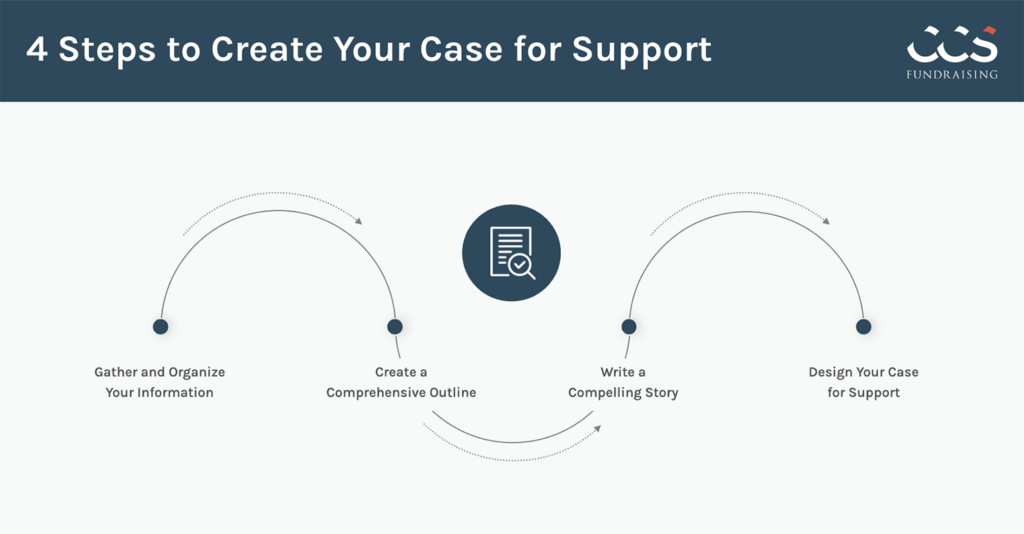
1. Gather and Organize Your Information
Gather current information about your plans, funding areas, and costs. Cast a wide net to include the following.
- Organizational information (i.e., mission, vision, strategic plan, branding guidelines)
- Program or project details/schematics
- Cost estimates
- Impact stories
- Photos/renderings/visuals
Categorizing and organizing your information before you begin writing reveals gaps and allows you to begin outlining your content and vision in a way that makes sense and is true to your organization.
2. Create a Comprehensive Case for Support Outline
After collecting information, create an outline of the content of your case statement. To start, answer the following questions using the information you collected.
- What issues does your organization target (mission)?
- What are your organization’s strengths?
- What challenge or obstacle do you face? How do you propose to overcome this obstacle?
- What are your funding needs?
- What will be the impact of fulfilling those funding needs? How will this change the community?
- What are you asking of the donor?
Your outline should include relevant details and be a relatively high-level organization overview, describing the challenge your organization faces, your future vision, and the impact the donor can make. Include only the most essential information and leave out anything irrelevant to your audience.
3. Write a Compelling Story
Using the outline you created, supplement your content with compelling language to motivate prospective donors to see themselves as an active participant in overcoming your organization’s challenges. An effective case for support includes an accurate description of how the donor will create transformational change. The closing should incorporate a “call to action,” a final invitation that propels the donors along the engagement pipeline.
4. Design Your Case for Support
The design of your website and collateral matters for how the public views you; 94% of first impressions are design-related .
After creating a compelling story, begin designing your case for support. Your organization may have defined branding guidelines—if so, use them to ensure your case is recognizable and aligned with your organizational culture.
If you have limited resources, designing your case for support can be challenging, but keep the following in mind.
- You can design using PowerPoint and draw inspiration by searching for other case statements.
- Be consistent with text size, margins, alignment, and other small details. Uniformity demonstrates professionalism and the document’s importance to prospective donors.
- High-quality photos can convey information more quickly and effectively than text. Consider taking new photos or using compelling stock photos that align with your mission.
- Use design elements such as bolding, titles, text boxes, and color to emphasize important information.
Finalizing a strong case
Writing your best case requires meticulous planning, drafting, designing, and editing. Along the way, you should share case iterations with other team members, volunteers, and prospective donors. Asking your stakeholders for feedback and building consensus throughout the case’s development prevents setbacks and builds familiarity throughout the organization. Likewise, following the steps sequentially is important, as jumping ahead is counterproductive and can create additional work.
As you begin, keep impact at the top of your mind. Drafting your case can seem overwhelming, but it is also exciting. You are embarking on a process that can create a ripple effect in your community and make a long-term difference for your organization. Bring that passion, excitement, and vision for the future with you as you create your most compelling case yet!
More Insights
5 steps to maximize your year-end fundraising appeal.
Did you know that 31% of annual giving occurs in December, with 12% taking place in the last three days of the year? Does your non-profit organisation have a strong year-end strategy to take advantage of these powerful trends? Read our five steps to maximise the success of your year-end fundraising appeal.
2023 Philanthropic Landscape, 12th Edition
Featuring essential philanthropic research from all major sources in the industry, this exclusive report examines key themes in American philanthropy and the latest data on giving by US individuals, foundations, and corporations.
- Privacy Overview
- 3rd Party Cookies
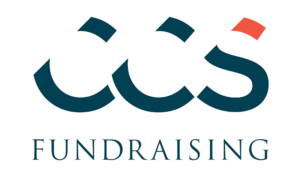
This website uses cookies so that we can provide you with the best user experience possible. Cookie information is stored in your browser and performs functions such as recognising you when you return to our website and helping our team to understand which sections of the website you find most interesting and useful.
This website uses Google Analytics to collect anonymous information such as the number of visitors to the site, and the most popular pages. Keeping this cookie enabled helps us to improve our website.
Please enable Strictly Necessary Cookies first so that we can save your preferences!
Create Compelling Nonprofit Case Studies with this Template
by Monica Samuel | Mar 28, 2020 | Content Development , Non profit , Resource | 0 comments
While working as a consultant with a large NGO, I wasn’t entirely happy with the kind of case studies that were churned out. They did not really tell a story. They had all the right facts, figures and outcomes but lacked heart. Since I was aware of the hard work of the field staff and the huge impact their efforts had on the lives of the organisation’s service recipients, I found this puzzling.
I looked at the raw information that came to the marketing team from the field. The information was just a clinical report – basic mention of the service recipient’s personal information, health and economic background, condition, challenges, interventions, progress and outcome. There wasn’t anything to give you an insight into the psychological and emotional experience of the person receiving care, the caregivers, family or community.
How does this happen?
Both the marketing team (if there is one) and field staff in most NGOs are significantly understaffed. Further, with resources moved between internal teams based on need, oftentimes the role a staff member is expected to execute is beyond their skill or aspiration. Everyone works but when skills, interest and capabilities collide, motivation and self-learning take a huge hit.
Another factor is the lack of adequate training. While NGOs invest great effort and time into the training and capacity building of their service recipients, many do not budget for or prioritise on iterative skill development of their staff. Not enough is done to help the staff improve their skills and grow in their roles.
NGOs are also prone to “sluggish processes” and “resistance to change”, a state true of many private/public organisations as well. Processes don’t change quickly enough. To me, that is a huge folly. But that’s a discussion for another day.
Coming back to the case study predicament … as I continued to see (and often create myself) more morgue-like case studies, I decided to change the process.
I would come up with a template for the field staff. The template would guide the field staff on the questions to ask of the service recipients. That way, the marketer would have the right information to develop a story. For every person has a unique story – her pain, anguish, joy, victory, thought and aspiration are uniquely her own. I developed the template over a course of some days, based on my observations and some research.
Rolling out a new process
Since the template was longer than what the field staff were accustomed to fill, I requested that it be filled for only one service recipient every month. The way I saw it, if we had twelve good stories at the end of a year, it was progress. And good enough to support our marketing efforts. Once the results from these improved stories started showing, we could use that to add impetus to the project.
Once we implemented the case study template, it took a while for people to use it. This is where constant encouragement from supervisors and managers can be quite effective, assuming they are sold on the value of this change first.
One staff member took the time to fill out the template as best as she could by spending good time with the service recipient and her family. The information we received was without doubt much more comprehensive, detailed and telling.
Extended opportunities
With the information at hand, we could create a much more powerful story that resonated with donors and supporters of the cause. The possibilities were extended – short case study (social media), long case study (blog, proposal or report), impact lines (video or image content), first-person quotes (video or image content), and more could now be created from a single document. That’s a big win.
Should your NGO also try this?
The template is successful in saving time and effort for the field staff as they don’t need to think from scratch. The marketing team wins because the pressure to create compelling stories with inadequate information is reduced. Never gone through! Expectations from NGOs, internally and externally, I have found, are always high.
I have the greatest respect for the staff at NGOs – the sacrifices they make and the extra miles they’re so willing to walk for the sake of service. So, I’m sharing the case study template here.
I hope it helps NGOs tell better stories of the wonderful work they do, day in and out.
Download the case study template for online entry (.docx).
Download the case study template to print for offline entry (.docx).
Share this:
- Click to share on LinkedIn (Opens in new window)
- Click to share on Facebook (Opens in new window)
- Click to share on Twitter (Opens in new window)
- Click to share on WhatsApp (Opens in new window)
- Click to share on Telegram (Opens in new window)
- Click to email this to a friend (Opens in new window)
- Click to print (Opens in new window)
Hey! Please share your thoughts. Look forward to hearing from you. Cancel reply
Recent posts.
- Nonprofit Marketing Case Study – The Association of People with Disability (APD)
- The DigiIndia Squad Journey So Far
- 6 Marketing Case Studies from Nonprofit & Small Biz
- Why Must All NGOs Send an Email Newsletter?
- Quick Digital Marketing Overview – Part 2
Recent Comments
- Brad Mathias on Marketing Tips for the Travel Sector in the Covid Crisis
- Monica Samuel on How to get ideas for content creation?
- Monica Samuel on How the Covid Pandemic Has Changed My Life
- Sindhu Rao on How the Covid Pandemic Has Changed My Life
- Sindhu Ramarao on How to get ideas for content creation?
- Bill's Corner
- Content Development
- Content Writing
- DigiIndia Squad Podcast
- Marketing strategy
- Miscellaneous
- Social Media

- Resource Guide

How to Write a Superb Case Statement

A superb case statement communicates to the donor why funds are urgently needed and why philanthropic support makes sense.
It’s critical for that to occur on the first page of the case, as this sample does so well, since many people will only read that page. “How can we ever say ‘no’?” the cover page asks. Right from the start the key question is posed and driven home.
When executed well, a case statement inspires your donors to invest in your future — and become ambassadors for your mission and vison.
Most people associate cases with campaigns, but you will also want to have one for your general mission and vision, the raison-d’etre for your nonprofit’s very existence. The latter should be updated each year.
Here are tips to help you write, and present, a top-shelf case statement.
I often write a short (five pages) and an extended version (10 pages) of the case, but recently I haven’t seen much need for the longer version.
I recommend creating a three to five-minute video of the case because your social media platforms demand it, plus it’s useful for major donor cultivation.
It is also important to invest in a dynamic graphic designer and a videographer to ensure that you’re choosing compelling and appropriate images. This is not the time to scrimp.
As you get started, consider the following:
- State the impact of meeting the fundraising goal: we will have expanded services or new facilities, or both?
A case statement shares your mission; but your mission is secondary to sharing the vision of the campaign, or that year’s particular annual fund focus. Placing the mission in a sidebar often serves well.
- State who will benefit from the donor’s gift.
- Boast of the organization’s strengths, yes, but profile a donor and tell the story for their reason for giving well.
- State how the potential donor can make a donation.
- Make clear the donor’s reward: lavish recognition, naming opportunities.
- Post your case on your web site and on social media, and email it to the major donor prospect prior to your online or in person meeting.
Build Your Brand
While your case statement is vital to the success of your campaign or annual fund drive, so, too, is your brand.
Campaign leaders that pay attention to branding are more likely to lead capital campaigns that perform at the highest level.
They conduct the careful work of developing a brand promise and build all the materials around communicating that promise — from the theme to the talking points, case statement, brochure, and microsite.
Take time to fully consider the promise you are communicating in your case and ensure that you’re carrying that promise through every communication that connects with the campaign or annual fund drive.
Avoid Writing by Committee
Case statements are a vital piece of any fundraising and should be prepared by fundraising counsel in concert with the organization’s CEO collaborating with a committee of the governing board.
There should be only one writer. Committees do not write; they give feedback, reject, or approve.
Drafts of the case are usually reviewed and modified by the development committee and then recommended as is to the governing board before they are accepted or sent back for revisions.
Ask for input and general feedback, but avoid asking for line edits. Use a professional copy-editor before sharing it with the board.
Write in the ‘Donor’s Voice’
The case must be written to the donor as if the donor were standing in front of you, and you were speaking directly to him or her.
We call this the “donor’s voice,” as contrasted with an “institutional voice,” or a voice narrating client stories. The case should not disrupt the conversation the document seeks to have with the donor.
Do You Need to Show Your Business Plan?
Some cases are backed up by strategic, project, or business plans. These documents are primarily internal to the organization unless the major donor wants that level of detail.
They can be incredibly valuable as you develop your case statement, since they articulate the fundamental reasons underlying your appeal for funds.
They may also contain other information critical to the organization’s work — the mission, goals and objectives, programs and services, staffing, governing board, facilities, and how funds are allocated.
Material for grant proposals and other campaign materials are often drawn from these core documents.
Less Is More
A great case statement, meanwhile, is written to be read by the public and potential donors.
Yes, it tells the indispensable story of your nonprofit and the community it serves, and explicitly states the case for special capital or reserve or endowed revenues; but it must never waiver from being a love letter to the donors. If the case does not speak to the donor it has failed.
Your case may be presented as a brochure, glossy portfolios, a speech, video, or even in letter format. Personal testimony should be included but only by the expert leaders of your nonprofit, or those close to them in expertise.
The case is not a research document whereby quotes from Einstein or lists of statistics are given. Less is more with a great case.
Lastly, remember that the case is just a tool and should take a back seat to having a terrific conversation with the donor. Fundraising should strive for deep relationships.
Many organizations waste way too much time in crafting the case when that time should be spent on donor research and securing meetings. If you’ve taken more than a month, you have taken too long.
If the case isn’t complete yet but the donor wants to meet, without trouble set up the meeting and bring what you have. Donor engagement and securing lead gifts outplay everything.
- Categories:
- Cause Marketing
- Copywriting
- Strategic Planning
Laurence is author of " The Nonprofit Fundraising Solution ," the first book on fundraising ever published by the American Management Association. He is chairman of LAPA Fundraising serving nonprofits throughout the U.S. and Europe.

Digital Methodology
Proven three-step approach to raising funds online.
Customer Reviews
1500+ nonprofits trust CauseVox. Read their reviews.
Expert Support
Main Street style helpful support from people that care.
We're unlike other fundraising software. Here's how it started.
Peer to Peer
Personal and team fundraising pages.
Event Ticketing
Sell free or paid tickets for in-person or virtual events.
Crowdfunding
Campaign pages for project fundraising.
Track donors and manage their giving history.
Forms and buttons for one-time and recurring giving.
Integrations
Connect CauseVox to other software.
Pledge Now, Pay Later
Take installment donations automatically.
Blog Articles
Latest fundraising tips and techniques.
Take a deep-dive into digital fundraising.
Guides & Templates
Free guides, how-to's, and templates.
Attend live or watch on-demand sessions with experts.
Case Studies
Read how other nonprofits are raising funds online.
Help Center
Support articles on how to use CauseVox.

Schedule Demo
Watch on-demand or book a live demo.
Find and post nonprofit jobs for free.
- Get Started
Why CauseVox?
What is a case statement for nonprofits (best practices & examples).
What is a case statement? Well, let me share a story that will help you better understand what a case statement is, why it’s important, and how to ensure your case statement resonates with potential donors.
Imagine you’re sitting down for coffee with a prospective major gift donor. Maybe you met her at an event for your organization, or a board member referred her. She’s somewhat familiar with your organization, but this is the first real meeting you’ve had, one-on-one.
After you’ve gotten through the small talk of settling in, Ms. Prospect says, “So tell me all about XYZ organization.”
If you’ve worked with your organization for any length of time, you probably have an “elevator speech” version of describing who you are and what you do, so you say something like, “XYZ organization claims empty spaces in urban environments and transforms them into community gardens. We teach people to grow vegetables and create space for neighbors to get to know each other.”
She nods enthusiastically. “Right. Great! Tell me more about that.”
DUN, DUN, DUUUUUUUUUUUN.
Your elevator speech is over. Now you’ve got to make a case for support.

The Case For The Case: Why You Need A Case Statement
Call it a “Case Statement” or a “Case for Support,” or “The Case,” but whatever you call it, you need it. You need an actual document that spells out why someone should give your organization money.
I know. This sounds like the kind of busy work that derails nonprofits all the time, doesn’t it? “Great!” you’re thinking, “I can spend a bunch of time creating a document that only I reference, that ends up sitting on the shelf in a binder, next to all those other documents that consultants and experts have told me I have to have.”
Your skepticism is understandable, but hear me out.
Defining and describing what you do, why it matters, and the reasons you need and deserve people’s support almost guarantees your fundraising will be more effective. With a clear case statement, you will be ready when Ms. Prospect asks to know more, and anytime you need to encourage people to give.
What Is A Case Statement?
The Association of Fundraising Professionals defines “case” as:
“Case, n. the reasons why an organization both needs and merits philanthropic support, usually by outlining the organization’s programs, current needs, and plans.”
You can write a case statement for a specific program or campaign, or for your organization as a whole. The document should be used both internally and externally. Internally, it will inform how you write and talk about your organization in fundraising endeavors. Externally, it persuades people to support you.
Your case should explain:
- Who you are
- What you do
- Why you’re doing it
- Why you’re different than other people doing that thing
- Why it matters
- How you’re doing it
- What you need to do the thing you’re trying to do
- The impact of donors and support
To get started brainstorming your case, consider one insistent question:
The fact is, “We do a good thing,” isn’t terribly compelling. Take it deeper by asking yourself, “So what?” What is your community coming together to do? Why does it matter? What will a donor be part of? What changes are you making in the world? Why should someone join you to make that thing happen?
In the end, your case statement won’t just be about you. It will be about a community coming together to make a change, and an invitation to join that community.
How To Use Your Case Statement
The case statement is the Swiss Army knife of documents. Anytime you’re writing or talking about your organization, the case for support can help you to be clearer, more targeted, and more inspiring .
So, back to Ms. Prospect. How does this document help your conversation with her?
When you’re cultivating a prospect, the case becomes a map for long-form storytelling . It gives you a cheat-sheet for the most important points to make. The case statement alone is not all you need, but it provides a structure for telling your organization’s story and inspiring giving.
What if you’re invited to speak at the local Chamber of Commerce?
Then the case is the outline of your presentation. A simplified version might provide the text for your slides. At the very least, the case is a checklist for covering all your bases.
Need a handout for a potential corporate partner to share with their bosses? Voila, the case!
Far from just another document on your shelf, the case statement can:
- Keep you on track and donor-focused when you’re asking for support
- Help other people make the case for your organization
- Give your community a clear and consistent way to share your mission
- Provide consistency throughout your fundraising activities
3 Conversational Superchargers To Help Craft Your Case Statement
Of course, you can’t just read Ms. Prospect your case statement. She can probably read herself, and she didn’t agree to coffee so that you could give her a bunch of information that is on your website. She wanted a meeting with an authority on your organization to learn if she wants to be a part of it. Supercharge your case with human stories, your personal passion for your cause, and active listening.
Human Stories Illustrate The Case
People give to people most of all, and human stories motivate giving.
Rather than reciting the case statement, find examples to demonstrate the points you make. Connect each point of the case with a real client, volunteer, or donor impact story. Stories connect more than statistics, and specifics mean more than explaining the entire scope of a program.
For our community garden organization, perhaps the case statement says we “combat social isolation by creating spaces for neighbors to get to know each other.” While talking to Ms. Prospect, or the chamber of commerce, I could tell a story of someone who was lonely who now has neighborhood friends, or how the neighbors have created more opportunities to spend time together.
“Professional” usually means “unemotional,” but that doesn’t quite work for fundraisers. People give because they have empathy, and most fundraising is emotionally-driven. That means there’s a place for your own emotions in your fundraising conversations.
People are influenced by the social and emotional cues other people give them. It’s okay if injustice makes you angry, or progress on an issue excites you. You’re asking your donors to care, it makes sense that you would care, too.
Your passion for your mission can be a powerful motivator for the donors you meet–don’t be afraid to show it. As long as you keep the focus on your cause, your emotions can increase your trustworthiness.
If you have a deeply personal connection to your cause, it’s often appropriate to share it. Just make the story about the cause, and what the organization does about it, more than telling your own life story.
The most important parts of your conversation with Ms. Prospect might not be anything you have prepared. It might be something she brings up or a question she asks. You can miss this if you’re too wrapped up in making your case for support, so it’s important to listen.
Leave space for your prospect to talk. Invite them to participate by asking questions like:
- What do you already know about XYZ organization?
- What interests you about our organization?
- What are you curious about?
- What kinds of causes are you already involved with? What about them interests you?
- What did you think of the event you attended?
Then listen. The best prospect meetings are a conversation, not a presentation.
The Case Statement Is An Invitation
Fundraising conversations and writing are persuasive, but they’re not argumentative. You can’t really argue someone into supporting your cause. Instead, fundraising invites donors to be part of something bigger. This is the core of your case statement, and the heart of your prospecting conversations: an invitation.
Just like your written case statement, make sure your fundraising conversations contain an explicit invitation, such as:
- Would you like to help?
- What kind of involvement interests you?
- Are you interested?
Any invitation can be accepted or rejected. Your prospect may not be ready to RSVP on donating. That’s okay. Keep the conversation going by inviting them to engage more, such as:
- What kind of information would you like to help you decide?
- Would you like to talk more about this later?
- Would you like to come see our programs in action?
Ready For Ms. Prospect
Armed with your case statement and conversational superchargers, you’ll be ready when people want to know about you. You’ll be focused on the cause, clearly represent who you are and what you do, and will make the best possible case for supporting your organization.
Want To Know More? Check Out These Posts
- 10 Persuasive Tips For Writing Fundraising Appeals
- Friendly Selling Techniques That Will Move Your Donors
Create a Killer Fundraising Plan - Best Practices, Strategies, & Downloadable Template
Fundraising Strategies for Nonprofits: Craft the Best Approach for Your Organization
SMART Fundraising Goals
How to Use a SWOT Analysis for Your Nonprofit
Maximize Giving Day Success with Peer-to-Peer Fundraising
Customer story: spur local raises over $1m with their give local campaign, donor personas: how to identify your unique donor audience, choose another topic to explore:, fundraising, peer-to-peer, social media, simplify and grow your fundraising.
It honestly felt like using CauseVox expanded our team by another member.
Kelly McLaughlin
Director of Donor Engagement at CCAN

Here's what we found for you:
Nothing on that. However, here are a few recommended searches others have found helpful:

Share via: Chances are, you know what Giving Tuesday is by now. However, it’s important to recognize that Giving Tuesday is just one of many giving days your organization can […]
Share via: Here at CauseVox, we love a good success story. And we couldn’t think of a better organization to highlight than Spur Local. Spur Local blew it out of […]

Share via: Do you ever go grocery shopping and see a product that feels like it was created for you? For me, it’s Oatly. And for Oatly, that is on […]
- Skip to primary navigation
- Skip to main content
- Skip to primary sidebar
- Skip to footer
Joe Garecht Fundraising
Maximize Your Fundraising. Multiply Your Impact.
Maximize Your Fundraising.
Multiply your impact., here’s a sample case for support for your non-profit.
by Joe Garecht

In this article, I’m going to walk you through the elements of a strong case for support, then give you a sample case statement you can use as a template for your non-profit.
What is a Case for Support?
Simply put, your case for support is your donor message. It’s an emotionally-compelling document that casts a vision for your organization and tells donors why they should invest in your work. If you’d like to learn more about what a case statement is and why it is so important for your fundraising program, read Here’s Why You Should Rewrite Your Case for Support This Year .
In this article, we’re going to be focused on the content of your case for support: telling you exactly what to include in your case statements, and giving you a sample case for support that you can download to guide your efforts.
The Components of a Successful Case for Support
There are lots of different ways to write case statements. I usually structure my cases for support around 7 key components. That being said, every non-profit and consultant has a different way of writing their cases.
You may use all of the same components I use… or perhaps add or subtract one or two. Or you might put things in a different order than I do. That’s ok – do what feels right for your organization. The important thing is to make sure that your case statement tugs at the heartstrings and makes donors want to write a check to support your work.
Here are the 7 components I use when I write a case for support:
#1: An Emotional Opening
A great emotional opening is crucial to the success of your case for support. Donors and prospects will use the first paragraph or two of your case statement to decide whether or not the rest of the document is worth reading. For that reason, you will need to use your opening paragraphs to hook your readers and make them want to keep learning more.
Avoid the temptation to start with something like, “The history of our non-profit began in 1973 when Mary and Eugene Clark…” and instead start with something like, “The children were hungry and cold, and Eliza had nothing to give them. Each day, she cried from hunger… silently, so her two daughters wouldn’t hear her sobs.” Your opening should make the reader feel.
#2: Your Mission and Vision
Next, your case for support should move from the emotional opening to the reason your organization exists. This is the “why” of your non-profit, answering questions like: Why does our organization exist? What is the problem we are trying to solve? Why should people care? What is our big, bold vision for the future?
When outlining your mission and vision, think big. Remember that donors want to invest in big visions for the future. If your ultimate goal is a city where no child ever goes to bed hungry, say that. That’s an inspiring vision, and one that will get donors excited.
#3: Explanation of Your Programs
You’ve told the reader why your organization exists and explained the problem you are trying to solve (as well as your ultimate goal in solving that problem). Now, your case for support should tell the reader how you are solving the problem… what are you actually doing to meet that big picture vision for your non-profit?
This is where you tell the reader about your organization’s programs – including the programs you are currently running, as well as those that you would like to run in the near future. Include a short explanation of each of your programs. Avoid the temptation to include jargon… instead, write in clear and easy-to-understand language.
#4: History of the Organization
Now that you’ve explained your programs, give a brief summary of the founding of your organization and a short history of its work to date. This adds proof and credibility to your case for support. If you’ve been successfully running programs to address the problems you are trying to solve, then say so, even if your organization has only been in existence for 2 or 3 years.
If you are writing a case for support for a new organization, that’s ok too. Use this section to talk about why the non-profit is being founded, and give some details about the people who are on the founding board or team. Either way, including some information about the history of your organization will help build trust for donors and prospects.
#5: Outcomes, Stories, and Proof of Impact
Donors want to know that they can make a real difference in the world by supporting your non-profit. Your case for support should show proof that what you are doing is not only working, but is worthwhile as well. Use statistics and charts, but more importantly, tell the stories of those you have helped, and use testimonials from your clients, community leaders, and other supporters.
You may have a section in your case for support specifically reserved for outcomes, statistics, and stories. More likely, you will pepper these items throughout your case statement to help keep your readers emotionally engaged and interested.
#6: Financial Needs
Near the end of your case for support, it’s time to talk about money. How much money does your organization need to raise this year? How about over the next 3 years? Why does it need to raise that amount (what will it be used for?) Why do you need to raise it now ?
Be specific. Tell your donors what the money will be used for, and how it will impact your programs and those that you serve. Many non-profits also include some mission-focused giving levels in their case statements. For example, a homeless shelter may say that $1,000 would provide 20 beds and hot meals for one night… $5,000 would provide a full day on-site medical clinic… and $25,000 would provide much-needed equipment to expand the shelter’s kitchen facilities.
#7: Means of Support
Last but not least, tell your donors all of the different ways they can financially support your non-profit. Do you have a leadership giving or major donor program? What about an annual giving campaign? Do you offer planned giving opportunities? What about monthly giving, online donations, or donor giving clubs? Briefly spell those out here, and ask for your reader to make a donation to support your work.
A Note on Sections and Section Headings
Remember, your case statement’s sections might be different than those listed above, or in a different order. That’s ok. It’s also important to remember that the section headers you use shouldn’t not be technical, like those listed above. You should use emotional and mission-focused headings in your case for support.
Thus, in the outline above, there is a section called, “Outcomes, Stories, and Proof of Impact.” But in your case for support, you might call that section “Saving 1,000 Lives Per Year… Thanks to You,” or perhaps, “Keeping Your Town Safe Today, for Our Children’s Tomorrow.”
The Sample Case for Support
Enter your e-mail address below to receive your sample case for support. It will be sent to you via e-mail immediately after you click the button. This case statement is for a fictional non-profit called The Montreal Children’s Home. Please feel free to use this sample case for support as a template for your non-profit’s own case statement:
When you receive the sample case for support, you’ll also be registered for our free weekly e-mail newsletter, The Fundraising Blueprint Newsletter . If you have any questions about this case for support, or would like help with writing a case statement for your non-profit, please click here to contact me.
Share or Print this Article:
Get in touch.
Have a question or need help with your fundraising? Let’s talk!
[email protected] (215) 839-9085
We help you raise the money your non-profit needs to thrive.
Our Services »
What Folks Say
“GFA has been a vital part of increasing our fundraising revenue this year by 20%.”
Testimonials »
Let’s Connect

Get the e-book, plus weekly tips in our fundraising newsletter!
Here’s What To Include in Your Nonprofit’s Case for Support
Sierra Rogers
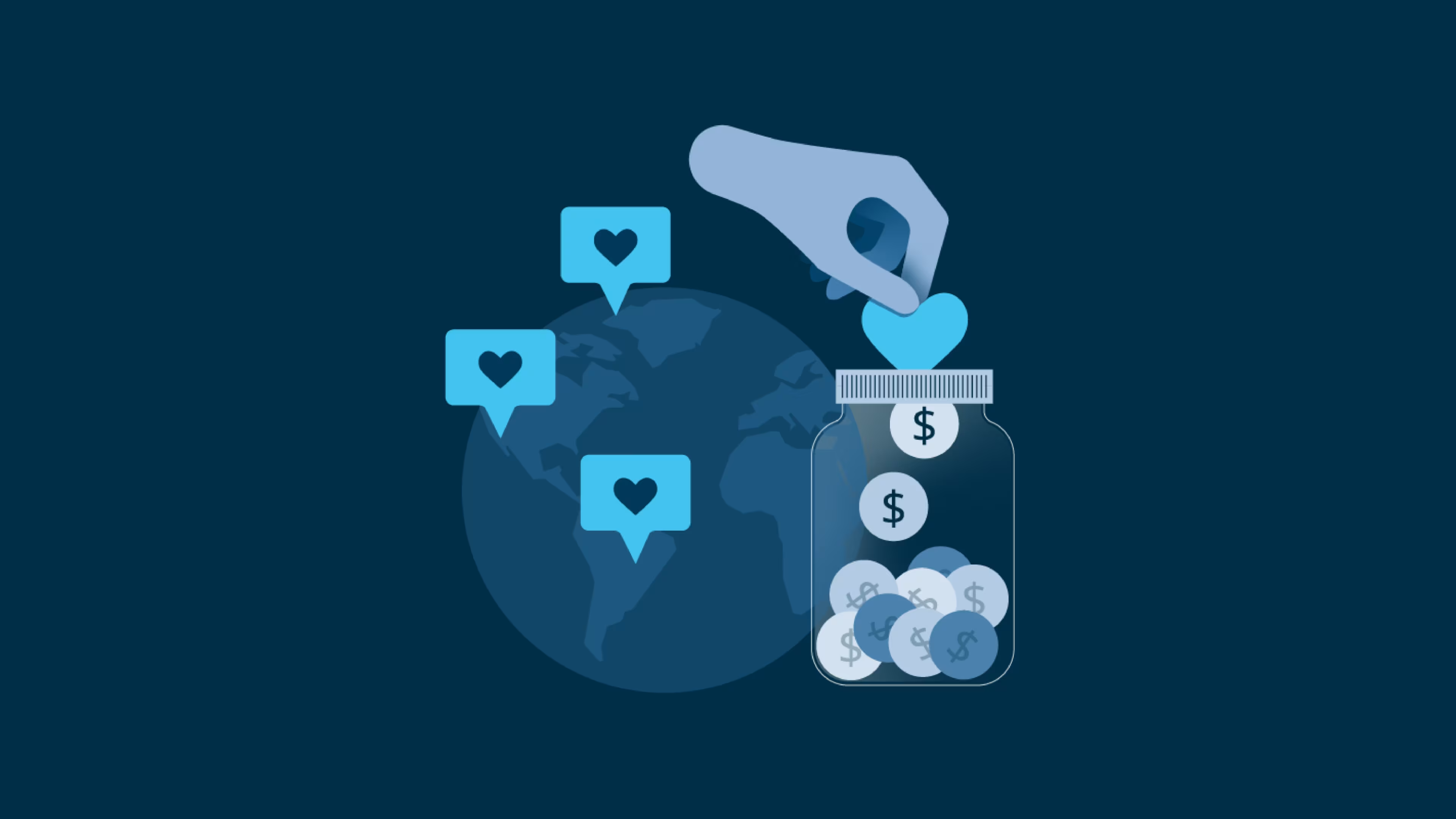
What is a case for support?
What does a case for support typically entail, every fundraising campaign needs a case for support. here’s what to include..
As a part of your nonprofit’s fundraising committee, you know that securing donations or funding is no walk in the park. Unless your organization has years and years of credibility as an honest nonprofit to lean on, you have likely felt like a salesperson for your mission when convincing potential donors to support you.
Fortunately, there are tactics you can use to make fundraising easier, and one of the most commonly utilized ones is creating a case for support.
Whether your nonprofit is launching a brand new program or is looking to secure further funding for an existing one, if you want your fundraising efforts to be successful, you need a case for support.
Ahead, we’ve got everything you need to know about creating your own case for support, including explanations of each element you should have within one (complete with examples), plus a template you can download to get a head start on creating your own.
A case for support is a document put together by a nonprofit for prospective donors. The purpose of this document is to communicate what your organization does, the impact of your work, and most importantly, why a potential donor should support you.
A case for support can also be referred to as a “case statement” or “donor prospectus,” and the focus of your case statement can be centered on a specific campaign (such as securing funding for the launch of a new initiative), or to give a more general overview of your organization and all of its programs.
One of the most common types of case statements is a capital campaign case for support . Nonprofits create these for extensive fundraising campaigns in which they need to raise a substantial amount of money for a new project or undertaking.
Now you know the definition of a case for support, but what does one actually look like?
While every organization’s case for support will look different, the elements they include are typically as follows:
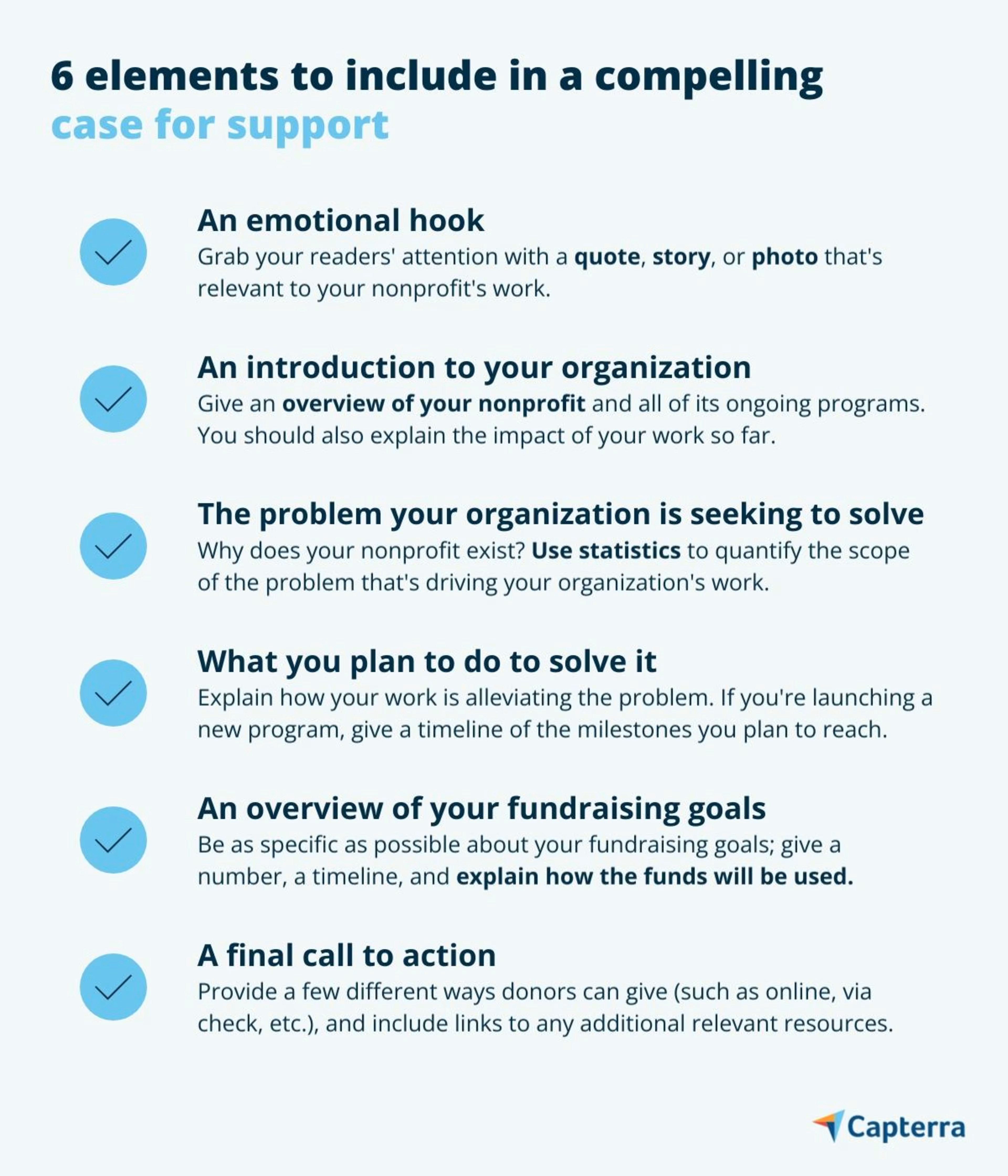
An emotional hook
In the same way that a pilot episode determines whether a TV show will stay on the air, the first few lines of your case statement will influence whether potential donors continue to read. So, in order to draw your audience in and make them care about your mission, you should begin your case for support with an emotional hook. You can do this by featuring a quote or story that highlights the needs your organization is determined to meet.
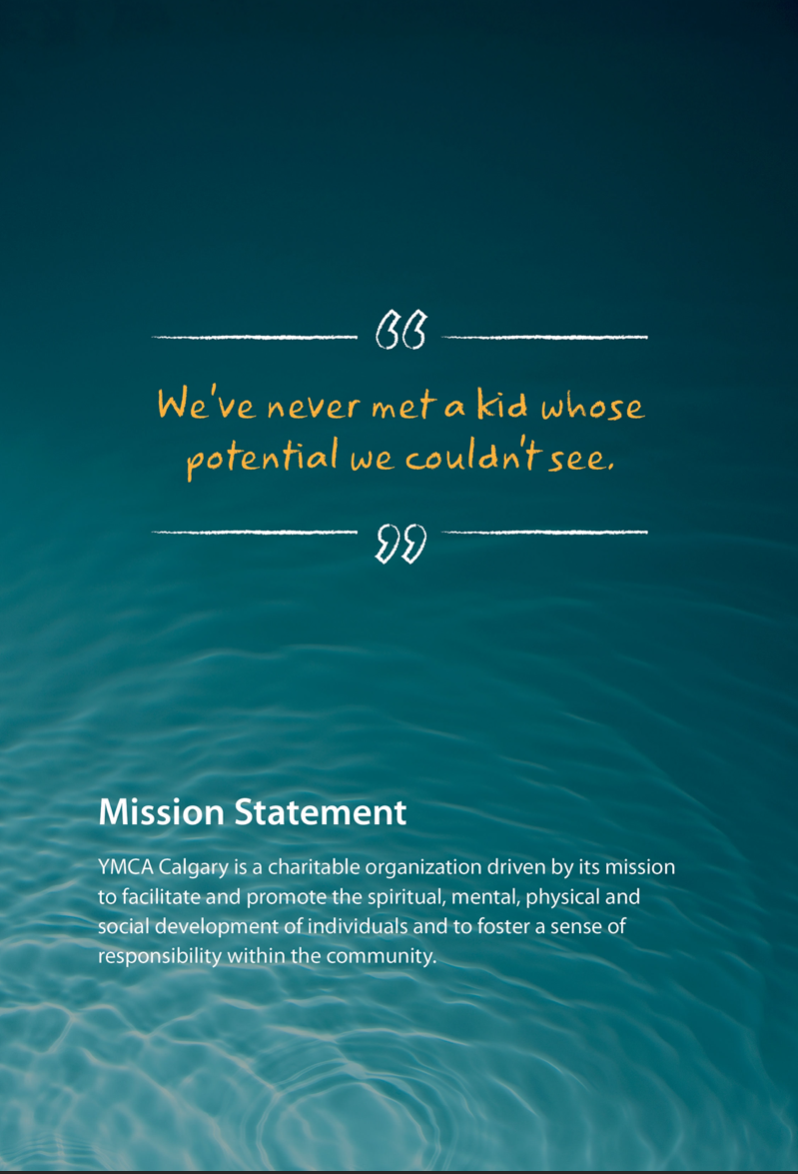
A quote featured in YMCA Calgary’s Power of Potential Campaign Case for Support ( Source )
An introduction to your organization
Next, you’ll introduce your nonprofit organization to your potential supporters. Start with your mission statement (like YMCA did in the example above), then give a brief overview of the history of your organization and all of its ongoing programs. You can also share the names and headshots of key members of your board or fundraising team here as a method of building familiarity with your audience.
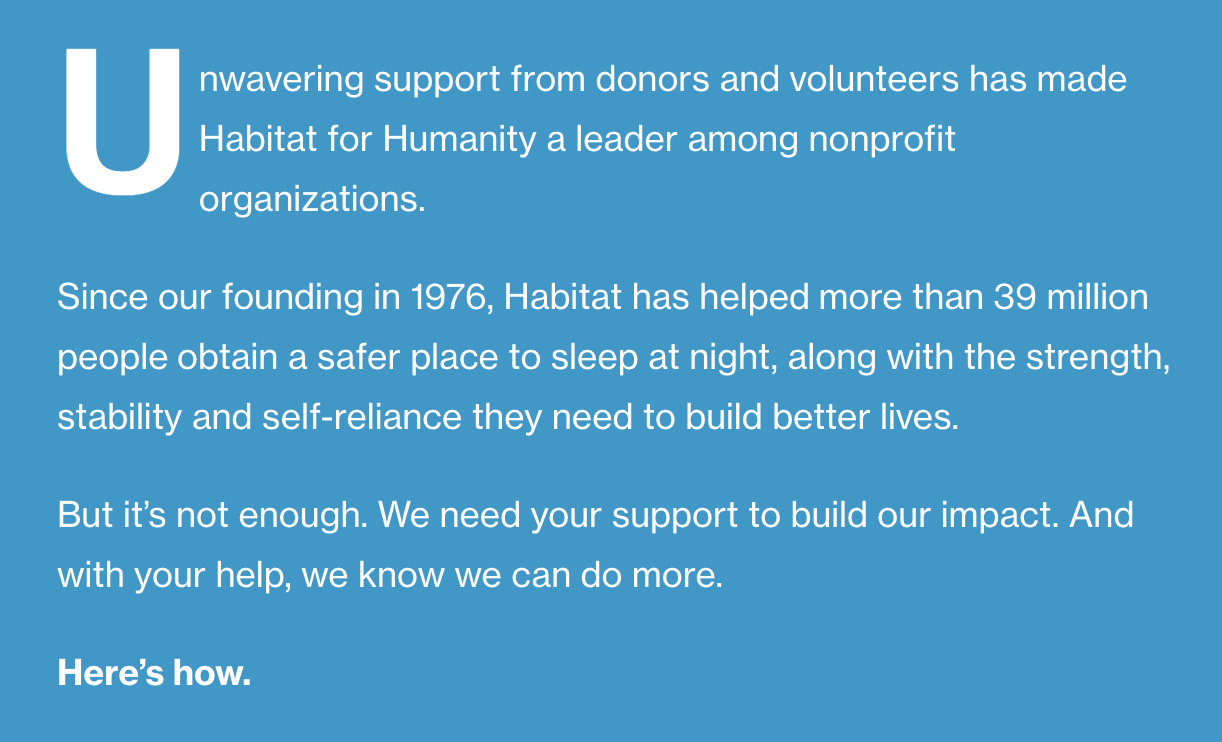
An excerpt from Habitat for Humanity’s case for support introduction ( Source )
Tip: As you should with all fundraising communications, keep your audience in mind here. For example, if this case statement is for a new initiative launch and will be shared with individuals who have been benefactors in the past, you don’t need to go too in-depth when introducing your nonprofit.
The challenges your organization is addressing
What is the problem that your organization is seeking to solve? In order to have an effective case statement, you need to be able to communicate that clearly to a prospective donor. Using a combination of emotional and rational language, detail the challenges your nonprofit’s efforts are addressing. We highly recommend including statistical data that illustrates the scope of the problem your nonprofit is trying to solve, like in the example below.
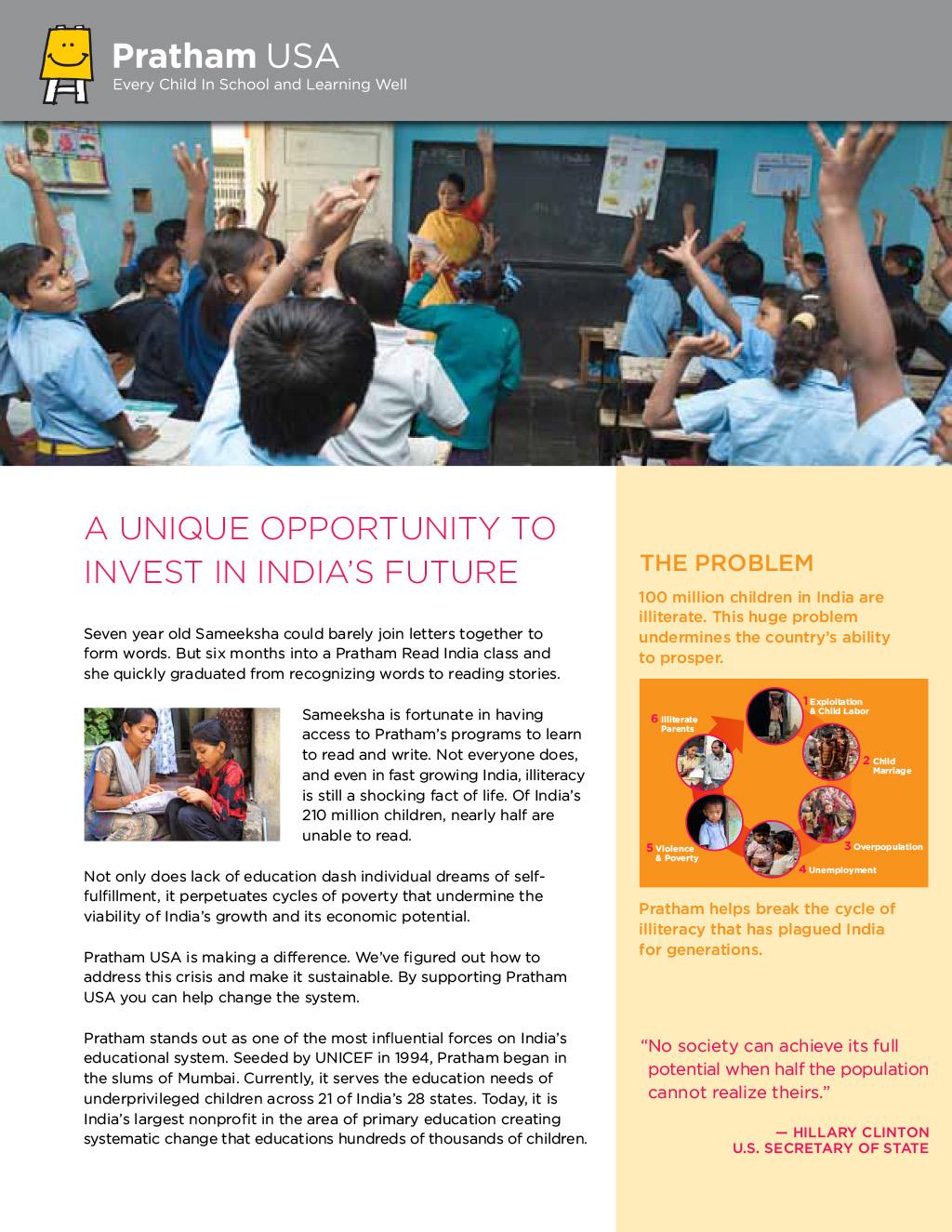
Pratham USA’s case for support clearly defines the problem their organization is working to solve ( Source )
What you are doing to address the problem
Once you’ve laid out the problem in your case for support, it’s time to present your plans for resolving it. If the purpose of this case statement is to act as a general call for donors to support all facets of your organization, you should include explanations of each of your ongoing programs and proof of the impact they've had to date, whether in the form of a testimonial or data, or both.
Alternatively, if this case for support is being used to acquire funds for a brand new program, you should give an overview of the project and provide a timeline of the first few milestones you plan to achieve through it.
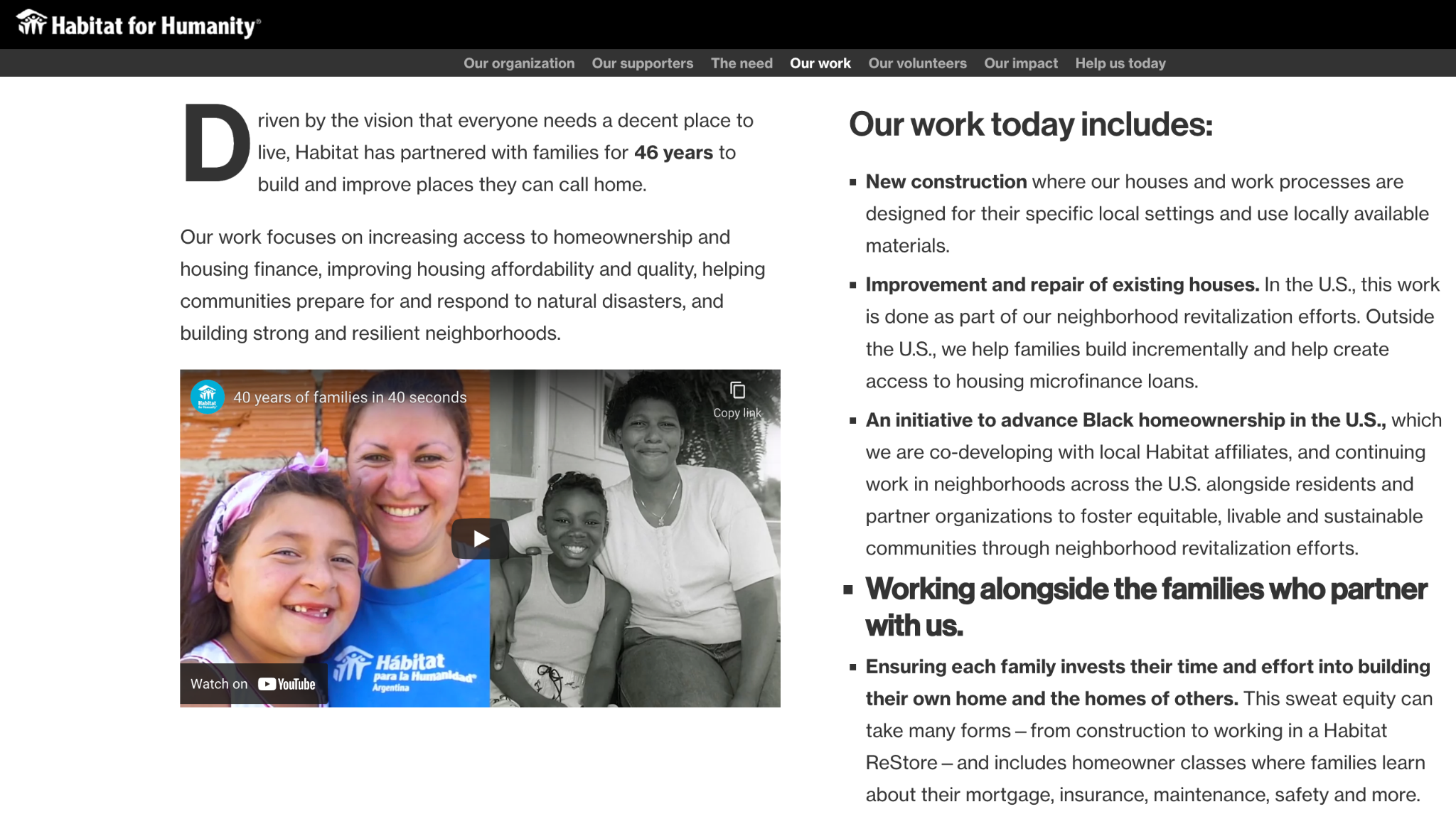
Habitat for Humanity explains their program offerings in their case for support ( Source )
An overview of your fundraising goals
This is the most important section of your case for support because it’s your opportunity to ask the reader to contribute to your cause. Before you do that, though, you need to show that your nonprofit has a well-thought-out plan for what to do with your supporters’ financial contributions. If possible, try to include data visualizations of how funds have been allocated in the past and testimonials from former donors and members of the communities you serve.
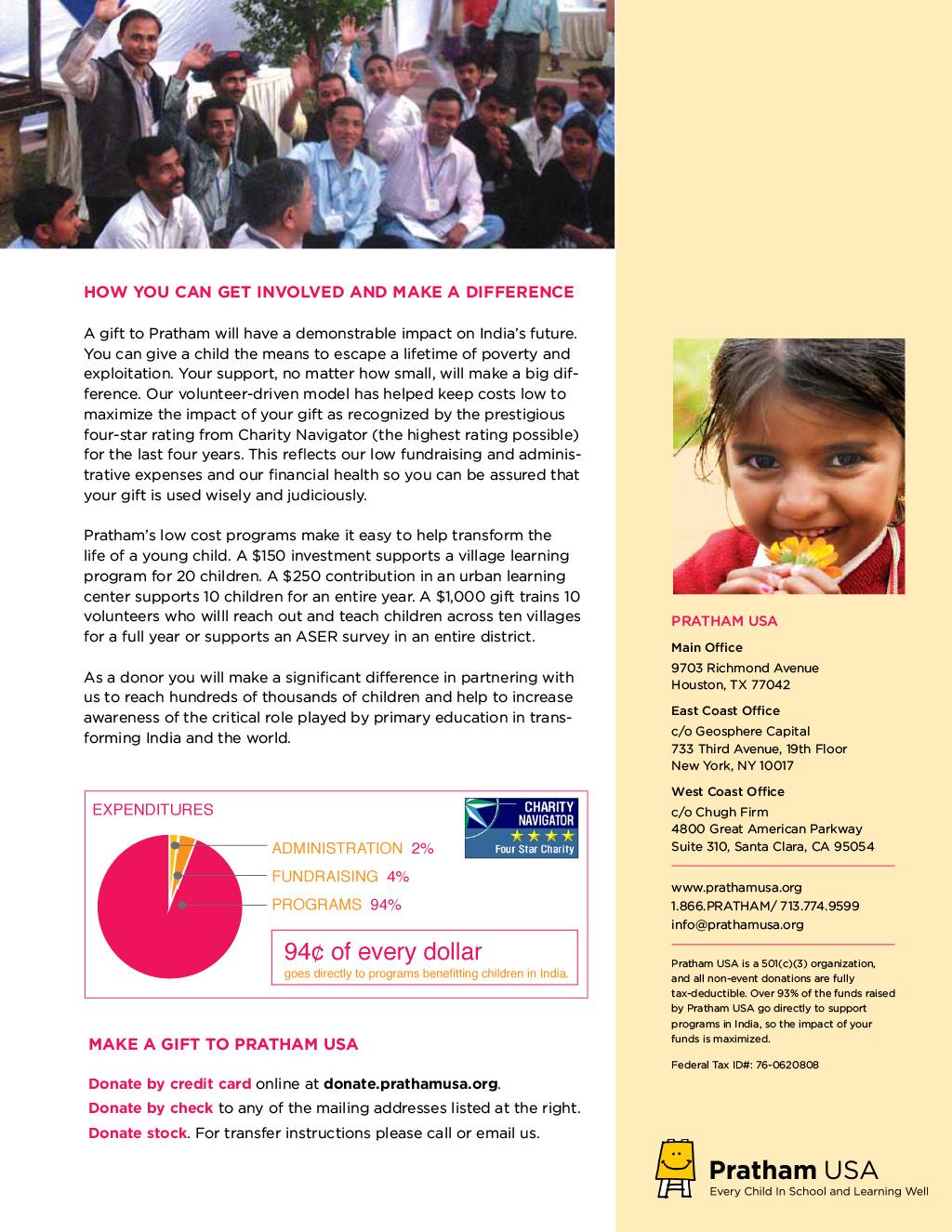
Pratham USA’s case for support includes data visualization and explanations of what different levels of contributions accomplish ( Source )
Here’s a few questions that will inform what you add to this section:
What are your funding needs? Answer this question for your readers right off the bat. Include a clearly defined fundraising goal that has a timeline and a financial figure attached to it.
What will be the impact of fulfilling that fundraising goal? Don’t just detail which programs will benefit from donors’ contributions—try to communicate the change or actions that will become possible because of it. For instance, the Freerice game is an initiative where every question that’s answered correctly raises the cash equivalent of 10 grains of rice for the United Nations World Food Programme (WFP)—a great example of tying a specific outcome to the input of those who participate.
How will this create a change in the community? If you are successful in reaching your fundraising goal, what will be the outcome of your organization’s efforts? You can use more emotional language here. Continuing with the example from the World Food Programme’s Freerice game, they will say that they will be able to improve food security and nutrition for communities facing emergency situations through donors’ involvement.
A final call to action
To wrap up your case statement, include a final call for supporters to donate. Add instructions for how they can do this in multiple ways (such as online, via check, or over the phone). If you have any other resources you’d like to plug here, such as a donor communications group, include those as well.
Habitat for Humanity’s case for support CTA includes a contact form, a reiteration of what donations help them accomplish, and links to additional resources ( Source )
You can also end on an inspirational note by including your vision statement, which is different from your mission statement in that it describes what your nonprofit hopes to accomplish in the future rather than what you’re doing right now.
Capterra tools and tips
Whether you’re working on securing philanthropic support, recruiting volunteers, or improving your communications, we’ve got the resources you need to make that happen. Before you X out of this content, check out these additional tools and tips:
Download Capterra’s case for support template , a simple tool meant to help you brainstorm what to include within each of the six sections of a case statement we covered in this article.
Browse top-rated and free tools in our graphic design software directory . Strong case statements effectively use visuals and branding to pique a potential donor’s interest. Our graphic design software category has nearly 200 different tools to explore, and you can filter products by their user ratings, pricing, and features.
Read more nonprofit-related content on our blog. We’re constantly updating our blog with new resources for nonprofit professionals just like you. Check out our latest content, Here's How (And Why) Nonprofits Should Work Towards Digital Maturity , for a sample of how our research translates into valuable insights for you.
Was this article helpful?
About the author.

Sierra Rogers is a senior content writer at Capterra, covering human resources, eLearning, and nonprofits with expertise in recruiting and learning and development strategies. With a background in the tech and fashion industries, she has extensive experience keeping her finger on the pulse of the latest trends and reporting on how they impact our world. Sierra enjoys cooking and dining out, collecting vintage designer goods, and spending time with her pets at home in Austin, Texas.
Related Reading
5 key construction management software features with top products that offer them, 5 key employee scheduling software features and top products that offer them, what is a call center, 5 key digital signage software features with top products that offer them, what is employer branding and how to build it, inbound links: what are they and how they help, capterra software buyers guides methodology, important financial ratios for businesses, how to keep books for a small business.
404 Not found

Case Study: How One Non-Profit Turned Their Fundraising Around Through Better Planning

Several years ago, I had the opportunity to work with a mid-sized non-profit that was struggling mightily to raise money. The organization had been around for several years, and like many non-profits in the post-startup phase, had gotten big enough to be adding staff and services for clients, but was still small enough that there was no full-time development director.
When I sat down with the Executive Director and Board Chairwoman, it was clear that this organization had big plans, but no clue how to raise the revenue to get there. This fact was clear from their answer to the first question I asked…
Me: “Can I see your fundraising plan?”
Them: “We need to raise $550,000 this year.”
Me: “Can I see the written plan for how you plan to do that?”
Them: “We don’t have one.”
Instead of a written (or even an “in our head only”) fundraising plan, this non-profit simply jumped at every fundraising opportunity that came across their desks.
Story in the paper about a similar organization getting a grant? Let’s drop everything and spend the rest of the week writing a grant proposal for that same foundation!
Board member has an idea for a new fundraising event? Great! Let’s hold it next month. I’ll get an invitation list together today.
Executive Director realizes the organization hasn’t sent out a fundraising letter yet this year? Let’s send one out on Friday!
The non-profit had spent two years operating this way… jumping from task to task, idea to idea, raising money in bits and pieces here and there. Thus far, they had managed to stay afloat, but had not been able to break away from living hand to mouth, fundraising receipt to fundraising receipt.
A Common Problem
This is no way to run a successful non-profit, yet it is a very common problem I see at small and mid-sized organizations. Far too many otherwise strong charities are running without a written fundraising plan. ( For more information on why you need a written fundraising plan, read How to Write a Successful Fundraising Plan ).
When I ask why, they generally tell me that it is because developing a fundraising plan would take too much time… or that they would need to spend a ton of money bringing in a consultant to write the plan for them.
Nothing could be further from the truth. Developing a written fundraising plan need not be onerous or costly. In fact, your non-profit can follow the same path I took with the organization mentioned above. Here’s how we went about developing a solid, written fundraising plan to guide their development efforts over the following year:
1. Gather the Stakeholders
First, we gathered all of the key stakeholders at the non-profit across several different meetings, including board members, key donors, staff, and other supporters. At these meetings, we discussed where the organization was headed, what types of fundraising these supporters would be willing to help us do, and where these folks saw opportunities for further growth in our efforts.
2. Develop a Budget
Second, I asked the organization to develop a budget for the coming year. Shockingly, this non-profit was operating without a budget – they had no financial plan together for how money was to be spent the coming year. I told them that it is impossible to develop a fundraising plan without knowing how much you need to raise, and it is impossible to know how much you need to raise without knowing how much you need to spend the coming year.
The organization developed a budget for what they wanted to spend on programs and overhead, and we used that as a guide for how much we needed to raise.
3. Review Past Fundraising Efforts
Third, the staff and I took a close look at the organization’s past fundraising efforts. They had some huge financial successes, and a couple of big blunders. What had worked in the past? What didn’t work? What could have worked if it had been done a little differently?
4. Develop a Fundraising Calendar
Next, we pulled all of the strategies and tactics we wanted to incorporate into the coming year’s fundraising efforts and developed a fundraising calendar that listed what we were going to do, when we were going to do it, and who was going to be responsible for making each task happen. We also listed revenue and expense goals for each fundraising tactic.
Due to the limited resources at this organization, we decided to use this fundraising calendar as the “meat” of our fundraising plan, rather than writing out a 45 page narrative.
5. Get Buy-In
Once the plan was completed, the final step was to get buy-in from everyone who had a stake in its success.
First, we held a meeting with the staff (including the program staff) to explain the plan and what we needed from each staff member. Then, we met presented the plan at a board meeting and had the board vote to officially approve the plan. Finally, we took the plan back to the donors we consulted in step 1 and showed them the finished product and asked them to get on board and help us expand our fundraising network.
Ultimately, the plan was a huge success . The organization, which had been shifting aimlessly from tactic to tactic in years past instead followed the plan, and by year two had become so successful that they were able to hire a full time development director as well as attract several major multi-year gifts through the tactics laid out in the fundraising plan we developed.
Photo credit: StarGardener

Copyright © The Fundraising Authority 2023
Login with your site account
Remember Me
Not a member yet? Register now
Register a new account
I accept the Terms of Service
Are you a member? Login now

Hacking the Case Interview

If you are interviewing for a nonprofit consulting firm, expect to be given several case interviews, or case study interviews, during your interview process.
All of the top nonprofit consulting firms, such as Bridgespan and the McKinsey Social Initiative, use case interviews to evaluate candidates. You’ll likely need to nail every single one of your case interviews in order to receive a consulting job offer.
If you have an upcoming nonprofit case interview, we have you covered. In this article, we’ll cover in detail:
- What is a nonprofit case interview
- The 7 steps to solve any nonprofit case interview
- Nonprofit case interview examples
- Nonprofit case interview tips
- Recommended non-profit case interview resources
If you’re looking for a step-by-step shortcut to learn case interviews quickly, enroll in our case interview course . These insider strategies from a former Bain interviewer helped 30,000+ land consulting offers while saving hundreds of hours of prep time.
What is a Nonprofit Case Interview?
Case interviews are a special type of interview that every single consulting firm uses. They are almost exclusively used by consulting firms, although some companies with ex-consultants may also use them.
A case interview, also known as a “case” for short, is a 30 to 45-minute exercise in which you and the interviewer work together to develop a recommendation or answer to a business problem.
For nonprofit case interviews, these business problems can be anything that a nonprofit or NGO faces:
- How can the American Red Cross increase the number of blood donors?
- How can the World Health Organization prevent future pandemic outbreaks?
- How can the Bill and Melinda Gates Foundation best allocate their budget to tackle the most important and impactful public issues?
- How can the World Wildlife Fund increase general public education on sustainable vs. unsustainable food sources?
Case interviews are used by nonprofit consulting firms because they are the best way for firms to predict which candidates will make the best consultants. Case interviews do not predict this perfectly, but they come quite close.
Since case interviews simulate the consulting job by placing you in a hypothetical business situation, interviewers use case interviews to see how you would perform as a hypothetical consultant.
Many of the skills and qualities needed to successfully complete a case interview are the same skills and qualities needed to successfully finish a consulting case project. These skills and qualities include:
- Logical, structured thinking : Consultants need to be organized and methodical in order to work efficiently.
- Analytical problem solving : Consultants work with a tremendous amount of data and information in order to develop recommendations to complex problems.
- Business acumen : A strong business instinct helps consultants make the right decisions and develop the right recommendations.
- Communication skills : Consultants need strong communication skills to collaborate with teammates and clients effectively.
- Personality and cultural fit : Consultants spend a lot of time working closely in small teams. Having a personality and attitude that fits with the team makes the whole team work better together.
Case interviews also give you a sense of whether you would like the consulting job. If you find case interviews interesting and exciting, you’ll likely enjoy consulting. If you find case interviews dull and boring, consulting may not be the best profession for you.
The 7 Steps to Solve Any Nonprofit Case Interview
Although you cannot predict the exact case interview question or business situation you’ll be given, almost all case interviews follow a similar structure or flow. Therefore, you can follow these seven steps to solve any nonprofit consulting case interview.
1. Understand the case background information
The case interview will start with the interviewer explaining the case background information. Make sure that you are taking notes while the interviewer is speaking. You’ll want to focus specifically on understanding the context, the company, and the objective of the case.
The most important part of the case interview is to make sure you understand the business issue and objective of the case. Addressing the wrong business problem is the quickest way to fail a case interview.
2. Ask clarifying questions
Once the interviewer has finished giving you the case information, you’ll have an opportunity to ask questions.
While you can ask any question that you want, try to prioritize asking questions that help you better understand the situation and problem. You want to avoid asking questions that are too specific or not relevant to understanding the case situation.
Most candidates ask between one to three questions. You’ll be able to ask more questions later in the case interview if you need to.
3. Summarize the information and verify the objective
Once you have finished asking your immediate questions, summarize all of the major case information and verify that you understand the objective correctly.
In this step, many candidates make the mistake of stating every fact of the case verbatim. Instead, you should summarize the case concisely and clearly in your own words. This demonstrates that you can synthesize information effectively.
4. Develop a framework
The next step is to structure a framework to help guide you through the case.
A case interview framework is a tool that helps you structure and break down a complex problem into simpler, smaller components. Think of a framework as brainstorming different ideas and organizing them into different categories.
To develop a framework, ask yourself what are the three to four major questions that you need to answer in order to make a confident recommendation?
Many candidates make the mistake of using memorized frameworks and applying them to their case interviews. Interviewers can tell when you are using a memorized framework because not all of the elements of the framework will be relevant to the case.
Using a memorized framework reflects poorly on your capabilities because it shows that you cannot think critically for yourself. Therefore, practice creating unique and tailored frameworks for each case that you get.
For a complete guide on how to create tailored and unique frameworks for each case, check out our article on case interview frameworks .
When creating your framework, it is acceptable to ask the interviewer for a few minutes of silence to collect your thoughts. Afterwards, present your framework to the interviewer.
5. Kick off the case
Once you have finished presenting your framework, the interviewer may agree with your approach or may provide some feedback or suggestions. Afterwards, it is time to start solving the case.
How the case investigation will start depends on whether your case is a candidate-led or interviewer-led case. Most cases are candidate-led.
Candidate-led case : In this type of case, you will be expected to drive the direction of the case. You will be suggesting what areas to explore, what analyses to do, and what the next step should be. So, pick an area of your framework to start analyzing. There is no right or wrong area to pick as long as it is relevant to solving the case.
Interviewer-led case : In this type of case, the interviewer will be leading the direction of the case. They will be asking you specific questions that you will answer. After each question, they’ll direct you to the next question. For interviewer-led cases, the interviewer will typically kick off the case by asking you a question after you finish presenting your framework.
6. Answer quantitative and qualitative questions
The majority of the interview will be spent answering a mix of quantitative and qualitative questions.
Quantitative questions may have you estimate the size of a particular market, perform some calculations to determine profitability, or interpret various charts and graphs.
When solving quantitative problems, make sure that you walk the interviewer through your approach before you begin doing any math. When performing calculations, make sure to talk through your steps out loud so that it is easy for the interviewer to follow your work.
Qualitative questions may ask you to brainstorm potential ideas or ask for your judgment on an open-ended business question. When answering these questions, try to structure your answer as much as possible.
After answering each question, make sure that you take your answer and connect it back to the overall case objective. How does your answer help you solve the case? How does your answer impact your potential recommendation?
7. Deliver a recommendation
At the end of the case, the interviewer will ask you to prepare an overall recommendation. It is acceptable to ask the interviewer for a minute to look through your notes before you give your recommendation.
Based on the quantitative and qualitative questions you have answered, what recommendation do they collectively support?
Structure your recommendation in the following way:
- State your recommendation
- Provide the two to three reasons that support your recommendation
- Propose next steps that you would take if you had more time
After you deliver your recommendation, the interviewer will conclude the case interview. If the case interview was based on a real life project, the interviewer may explain what actually happened in the case.
Don’t worry if your recommendation does not match what actually happened during the project. For case interviews, you are not assessed on your answer, but on your process.
Nonprofit Case Interview Examples
Below, we’ve compiled all of the nonprofit case interview practice cases and examples that we could find from the top consulting firms. You can work through these cases to practice your case interview skills and identify improvement opportunities.
- (McKinsey) Diconsa case : This case focuses on deciding whether to leverage a chain of convenience stores to deliver basic financial services to inhabitants of rural Mexico.
- (McKinsey) National Education case : This case focuses on helping an Eastern European country’s Department of Education improve their school system.
- (Bridgespan) Home Nurses for New Families case : This case focuses on helping a nurse home visitation program develop a strategy for growth.
- (Bridgespan) Reach for the Stars case : This case focuses on helping a national initiative focused on improving student success in community colleges develop a strategy for growth.
- (Bridgespan) Robinson Philanthropy case : This case focuses on helping a philanthropy group develop a strategy for selecting organizations to give multi-year, multi-million dollar grants.
- (Bridgespan) Venture Philanthropy case : This case focuses on helping a charity group select opportunities for high-impact philanthropy.
For the first McKinsey case above, we’ve provided a full video walkthrough of how to solve the case. This should give you a clear idea of how to put the case interview strategies we’ve outlined to practice.
Nonprofit Case Interview Tips
Below, we’ve provided six of our best case interview tips to help you better prepare for your upcoming nonprofit case interviews.
Tip #1: Start preparing early
Mastering case interviews takes time. Many of the skills and techniques needed to solve case interviews can’t be learned in just a day or in a week. Ideally, start preparing for your case interviews at least a month or two in advance to give yourself enough time to learn and practice.
Tip #2: Be consistent with what strategies you use
Whichever strategies you decide on using for case interviews, make sure that you are consistent in using them. The more you use the same strategies, the better and more comfortable you will get using them. On interview day, you’ll have confidence that these strategies will help you nail your case interviews.
Tip #3: Practice with a case partner
Practicing case interviews with a partner is the best way to simulate a real case interview. There are many aspects of case interviews that you won’t be able to work on if you are doing mock cases by yourself. Casing with a partner lets you practice your communication, presentation, and collaboration skills.
Tip #4: Focus on improving one thing at a time
After doing some practice case interviews, you’ll likely have a long list of feedback and improvement areas. Try to focus on improving one thing at a time. Before each practice case, decide on the one thing that you really want to focus on and nail. This will be much more effective than trying to improve everything at once.
Tip #5: Be 80/20
You have limited time during a case interview to solve the case. Therefore, you won’t be able to cover all of the different areas in your framework and get answers to every single question that you have. Therefore, focus on the most important issues and use the 80/20 principle.
The 80/20 principle states that 80% of the outcome comes from 20% of your effort. During a case interview, focus on the most important questions or areas that will have the biggest impact or effect on developing your answer or recommendation.
Tip #6: Be enthusiastic
During the interview, display enthusiasm. This not only makes the interview more fun and interesting for the interviewer, but it also demonstrates that you are passionate about consulting and working at the firm. Interviewers want to hire candidates that love their job and work hard. Displaying enthusiasm is an indicator for these characteristics.
Recommended Non-Profit Case Interview Resources
Here are the resources we recommend to learn the most robust, effective case interview strategies in the least time-consuming way:
- Comprehensive Case Interview Course (our #1 recommendation): The only resource you need. Whether you have no business background, rusty math skills, or are short on time, this step-by-step course will transform you into a top 1% caser that lands multiple consulting offers.
- Hacking the Case Interview Book (available on Amazon): Perfect for beginners that are short on time. Transform yourself from a stressed-out case interview newbie to a confident intermediate in under a week. Some readers finish this book in a day and can already tackle tough cases.
- The Ultimate Case Interview Workbook (available on Amazon): Perfect for intermediates struggling with frameworks, case math, or generating business insights. No need to find a case partner – these drills, practice problems, and full-length cases can all be done by yourself.
- Case Interview Coaching : Personalized, one-on-one coaching with former consulting interviewers
- Behavioral & Fit Interview Course : Be prepared for 98% of behavioral and fit questions in just a few hours. We'll teach you exactly how to draft answers that will impress your interviewer
- Resume Review & Editing : Transform your resume into one that will get you multiple interviews
Land Multiple Consulting Offers
Complete, step-by-step case interview course. 30,000+ happy customers.
- The Economy
- Immigration
- Constitutionally Limited Government
- Criminal Justice
- Free Speech
- Strong & Safe Communities
- Future of Work
- Foreign Policy
- Health Care
- Case Studies
- Partner With Us

Changemakers choose us to help transform their effectiveness
Explore how you can supercharge the good you do by leveraging our capabilities including funding, network, and principles proven to help people thrive.

How a free digital platform allows anyone to get — or give — tailored tutoring

How one woman took on occupational licensing to start her business — and ended up helping millions

How one restaurant is beginning to change how society views youth involved in the criminal justice system

How one business coalition is changing perceptions of people with criminal records

How an innovative coalition is empowering displaced learners and workers with the skills to secure jobs of the future

How one young couple gained support and bipartisan collaboration for Right to Try legislation

How a nonprofit is tackling some of LA’s toughest issues — and creating a model to empower other cities

How a fitness-based nonprofit helps people overcome addiction and helps society more effectively tackle this crisis

How one nonprofit delivered accelerated learning to students in the COVID-19 pandemic — and set the standard for the future

How a program for nonprofits is creating a movement to break the cycle of poverty and change how society helps the least fortunate
You have big ideas. We have the capabilities, including funding, network, and principles, to help you go even bigger.
Find Ways We Can Partner With You
Are you a philanthropist? Our network of 700 business leaders and philanthropists is accomplishing far more together than by investing alone.
Invest With Us
Get inspiration and insights from leaders on the frontline of change. Sign up for our newsletter today!
Tackling complex problems alone can be challenging. Get inspiration and insights from leaders on the frontlines of change by signing up to receive exclusive and education content from these changemakers! Become a part of our empowering network of innovators today! Sign up today for our newsletter for changemakers.
- Fundraising with Stride
- Leadership Training
- Impact Investing
- Project Showcase
Social Enterprise Examples & Case Studies
The following case studies and social enterprise examples were written by the Wells Foundation to be educational and inspirational. We believe they serve as excellent examples of social entrepreneurship and how foundations can use impact investing to provide support. We hope sharing them will inspire new social enterprise ideas from others.
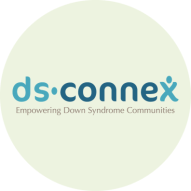
Additional Resources
- Always Innovate
- Think Entrepreneurially
- Serve Our Community
Submit a Request
First Name (required)
Last Name (required)
Email (required)
Organization
Comments/Questions
Which is bigger, 31 or 30?

Creating social DNA for a better world,
one community at a time.

Upcoming Event

Below are sample case studies of few of our engagements :
1. Strategic Planning
Our client is a $0.5 Mil non-profit organization that provides camping experiences for underprivileged youth in the San Francisco Bay Area.
Our client was at an organizational crossroads. The President of the organization was in the process of retiring and the board of directors was aging. Moreover, the client recognized its need to improve governance and decision-making in addition to better financial planning and controls. Revenue generation was also a major issue as the organization was dependent on a single Bingo game for all of its income. The client sought help from CLASS to create a strategic roadmap that would allow it to transition its leadership while becoming a more professional and sustainable organization.
The CLASS project team conducted a full internal and external analysis. This included a capacity assessment survey, interviews with key stakeholders, competitive analysis, financial modeling, and a final SWOT analysis. From this analysis, The team defined goals and objectives for the next three years based on this analysis. Strategic action plans were then developed along with identifying and defining key metrics for success.
Human Resource Planning
- Outlined options and created a blueprint for hiring a full-time executive director. Trade-offs and estimated compensation for each option were provided.
- Developed a plan for tapping into the local community to harness/ recruit volunteers to address specific needs.
- Recommended a by-law review to modernize governance and set the stage for leadership transition
- Provided by-law template
Financial Budgeting
- Uncovered and justified the need for annual and long-term budget planning via a board sub-committee
- Revenue Diversification
- Studied the opportunity for creating a sustainable private party rental revenue stream.
- Pointed out potential fundraising opportunities
Marketing Plan
- Defined techniques for spreading organizational awareness in the local community as a means of increasing private rentals
- Addressed need to improve visibility within the greater Optimist club network
- Created a plan for a website re-design
Metrics for Success
- Created a scorecard to track progress against goals
The CLASS recommendations clearly established realistic goals consistent with the client’s mission and within the organization’s capacity for implementation in a defined time frame. Through communicating those goals and objectives to the organization’s constituents, it will help align key stakeholders on the same page. The proposed marketing plan will help position the client’s brand in its competitive landscape. Human and financial resource planning will ensure the most effective use by focusing on the key priorities of the organization. The performance metrics provides a baseline from which progress can be tracked and measured. It will establish a mechanism for informed changes or adjustments whenever necessary.
2. Marketing Strategy
Our client is a foster and adoption services agency founded in 1996. It provides adoption, community training, parent advocacy, and behavioural health services to children and families at risk or involved with the foster care system.
The client’s mission is to empower children and families to develop the insights, life skills, and permanent relationships that promote their social, emotional, educational and economic well- being.
The client has approached CLASS looking for help in developing a marketing plan to support the long goals of the organization as well as providing specific marketing approaches for the upcoming gala event.
The client faced two major challenges that it hoped CLASS can help find solutions to:
- Limitations in availability and diversity of funding – The client’s revenue stream was dominated by government funding. This exposes the organization to significant financial risk in case of a cut in the government grant.
- Weak marketing infrastructure – The client did not have a marketing plan in place to support its fundraising and donor development initiatives.
The CLASS project team has worked closely with the client's leadership team to understand the key organizational requirements and the progress of various marketing initiatives undertaken, and to develop a detailed marketing plan. Data was gathered through a number of primary and secondary research sources spanning competitor websites, research journals, articles and media websites.
Our team has performed an in-depth analysis on the external and internal factors influencing the client’s environment to assess its existing situation and provide solutions to meet its goals and objectives:
Our analysis began by identifying various external Political, Economic, Social, Technological factors that may affect our client’s ability to achieve its mission and marketing goals. We then analyzed the marketing tactics employed by the client’s five key competitors to identify the areas of improvement in comparison with its competition. Evaluating various motivations, preferences, and requirements of the client’s three key stakeholders (Corporate donors, Individual donors, and social service agencies / volunteers / general public) revealed that the client needed to develop strategies specific to the various stakeholder groups rather than a blanket strategy with a single solution. Analysis on the various media channels used by most non- profits to promote their cause and reach out their target audience clearly shows that the growing importance of Website and Social Media over blogging, email marketing, and other traditional media such as newspaper. This leads to our conclusion that our client should primarily focus on leveraging various online and social media channels for enhancing the brand recognition by its donors, establishing creditability, and improving transparency with its target audiences. As a result of the various strategic analyses, we were able to identify the Strength, Weakness, Opportunity and Threat of our client. Our findings provided a strategic direction for the development of a comprehensive marketing plan.
After evaluating the needs of the client, our team identified the areas where our solutions can best help. We clarified the client’s key marketing goals and designed a detailed marketing plan to help the organization in achieving its long term and short term marketing goals. Our team identified the target audience categories through stakeholders’ analysis and developed customized marketing strategies and tactics to reach the audiences. Tailored marketing initiatives were also recommended for the client’s upcoming gala event. Key performance indicators were outlined to monitor the effectiveness of marketing efforts and scorecard was developed to compare performances.
To supplement the client’s marketing plan, our team devised a detailed social media strategy. We identified the appropriate social media platforms for the client and benchmarked the best practices for effective Social Media marketing. At last, we recommended detailed Facebook marketing tactics to promote the client’s major annual events.
The client’s leadership team was very satisfied with the strategies and tools recommended by the CLASS project team and strongly believed they would be very useful in creating impact on its organization.
Our impact assessment survey indicates that the client has implemented 50% of the proposed solutions as of March 2016, including Marketing Plan and Website and Social Media Strategy. The client is working towards completing it within the next 6 – 9 months.
CLASS marketing solutions have helped the client attract over 30% more corporate and individual donors and over 20% more volunteers. The client has implemented the new campaign strategy recommended by CLASS for its two recent gala events and it was proven effective!
The client has added two new social media platforms as per our suggestions. Traffic to its website and social media pages have increased by 26-50%, so as the number of new supporters/donors. The client found Facebook was most effective in achieving its marketing goals.
3. Organizational Development
The client was founded in 1996 as a Foster Family Program. Since then, it has grown into a comprehensive foster care and adoption services agency, providing adoption, community training, parent advocacy, and behavioral health services to children and families at risk or involved with the foster care system. Their mission is to empower children and families to develop the insights, life skills, and permanent relationships that promote their social, emotional, educational, and economic well-being.
Our client was looking for ways to have a more structured and stronger organization. As the organization is growing and evolving throughout its start-up phase, the organization has become more interested in fulfilling some of its basic functional needs. Some of these needs include establishing a board of directors who clearly understand their responsibilities as well as ensuring continued success with the programs and activities the client organizes each year.
In order to identify the client’s critical challenges and their most needed areas in further development, the CLASS team has started the project by conducting a thorough need assessment analysis, followed by several informational/planning meetings with the client. The meetings focused on some key areas where the client requires guidance. These areas are: 1. Defining the client’s organizational structure. 2. Identifying and building a board of directors. 3. Setting attainable objectives and goals for its members.
Based on the needs and challenges faced by the organization, The CLASS project team provide recommendations in the following three areas:
Key area 1:
Designing the organizational hierarchy with detailed job descriptions, responsibilities, and qualifications for members of the board and executive director
Key area 2:
- Developing plan of action for the client’s programs - setting long term goals and objectives for activities and template that will lead to improvements related to the volunteers and clients
- SMART objectives (Simple, Measurable, Attainable, Realistic, and Time-bound), process flow, and guidelines for creating a plan of action
Key Area 3:
- Designing performance assessment system for board that assess its performance and achievements as a team and individually and will increase mutual understanding, trust, and communications among the board members
- The assessment system includes board member performance evaluation template, evaluation rating system, tips for best practices, and most frequently used terms for evaluation forms
With the tools and guidelines developed by the CLASS team, the client can create a proper organizational structure, which will help increase their overall productivity and build improved relationships within the organization as well as with their clients.
Our guidelines for creating a plan of action will help the client focus on achieving their SMART objectives, ensuring program success, and continuing to meet both the client and community needs. The objectives are the measureable steps that can help board members achieve their annual goals.
The evaluation form for board members provides a simple, yet insightful method to evaluate and motivate members of the organization. It showcases their current achievements and future goals. Our assessment tool and guideline can provide the board with a chance to reflect on and evaluate its areas of strength and weakness and an invaluable yardstick to prioritize its future activities. Such a review can optimally result in all directors contributing to setting goals of the board. This is a good foundation on which to build positive change. The commitment to the board's priorities and to improving board effectiveness makes those goals more likely to be completed.
Our recommendations for properly implementing the CLASS solutions will help the board avoid some of the common pitfalls in execution, ensure successful completion of the solutions, and improve the client’s other areas of interest down the road such as fundraising, community outreach, and partnerships within the community.
4. Financial Strategy
Our non-profit client was founded in 1989 to help underserved elementary and middle school youth to realize their dreams through academic achievement by providing mentorship and positive role models. Through their partnership with 65 schools [as at February, 2011) with a base of more than 100 volunteers, the organization reached out to 5500 youth in Santa Clara County, to teach them character development, goal setting and career exploration.
The client's operating cost is covered by its donation income. Donations to the client come in several forms: grants (corporate & foundations), events fundraising and donations from corporate and individuals. Key challenges the client faces include:
- Significant drop in donations revenue: Its key source of donation in the past had been from the real estate developers. The organization had seen a huge significant drop in donations revenue due to the recent economic downturn. Response to its fundraising events, mainly golf and poker, had also seen significant decrease in the last 2 years.
- Unable to keep up with expenses: Due to limited donations in the past 2 years, the client has been unable to keep up with its expenses. The organization has tried to close this gap through credit card debt, emergency loans and delayed payment to a major vendor for its fundraising event.
- Slow reaction to budgeting & planning: The slow reaction to impending budget issues and limited resource planning resulted in a drop in its reserves from $60k to $10k in addition to the debt accumulation.
The CLASS project team divided the tasks related to this project into 3 milestones:
Milestone #1:
- Collection of data and requirements
- Analysis of the client’s accounting systems, priorities, and interviews
Milestone #2:
- Financial KPIs
- Base version financial model
Project completion:
- Financial Planning Tools (P&L, Budget and financial parameters)
- Various strategic scenarios analysis & recommendations
- Valuation Analysis*
The primary and immediate need of the organization is to have a better view of its financial situation and better control of its finances through cash flow management, in addition to valuation analysis to supplement its discussions with potential partner organizations.
The CLASS solution provides the financial framework which includes the following areas:
- Better understanding of cyclical revenue streams and ongoing cash flow requirements to support the strategic plan
- A 5yr P&L and Budget statements to provides a clear picture of the financial situation
- Debt restructuring strategies and timelines for the same which helps build reserves back to target levels
- Key performance indicators identified to help monitor performance
- A 4-metric social value assessment system to assist with the valuations
The financial models and debt restructuring strategies provide our client a better view of its financial situation and the cash flow needs in future. The increased visibility trigger preventive actions in managing financial and human resources, resulting better control on finances. The organization has a list of KPI’s in place to monitor its performance. It is also equipped with tools that convey the social value it adds to the society.
As of November 2011, the client had announced to go into a partnership with another non-profit organization and receive their support for their Role Model program which helped reduce their operational costs while increasing the outreach through the partner’s network.
Need more details? Contact us
We are here to assist.

Profitability Case
Profitability case - a framework for the most common case type in consulting interviews.
As you already know, there are several common case types that occur in case interviews you should familiarize yourself with. Profitability case interview questions are the most frequently used case types during case interviews for management consulting roles. Make sure to be prepared for them by internalizing our five steps to crack profitability cases.
Profitability Questions – The Number 1 Reason For Most Consulting Projects
The most common reason why firms instruct consulting firms with their projects is that they struggle with their profitability. You will have to find out the root cause of their declining profitability. Examples are falling sales , rising costs, or both . Your task will be two-fold: performing a structured and quantitative analysis of the data to isolate the problem, and then finding a promising solution for the problem .
Solve the Profitability Case Using This Case Example
We will explain the procedure along with a profitability case example just like the one you might encounter in a consulting interview: Your client is a chewing gum manufacturer (you can find the entire premium case here ). The CEO of the manufacturing company is concerned because his company is experiencing declining profitability . Please investigate the reasons for the decline and give suggestions for improvement.
The Five Steps to Crack a Profitability Case Problem
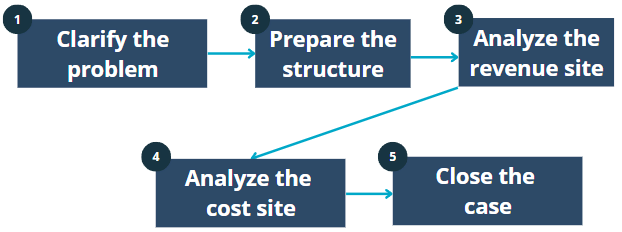
1. Clarify the problem
Remember the 4 commandments !
Take notes! Start with restating the problem: “Just so we are on the same page, our main objective is to determine the reasons behind the decline in profitability for a chewing gum manufacturer and provide recommendations to improve the profitability of the business, is that correct?”
2. Prepare your structure
“Thank you, may I take a minute to prepare my structure?”
As mentioned in the introduction, the terms “ declining profitability , falling sales or rising costs ” hint at a profitability case. You now have to isolate the problem and quantify it . A good start to analyze a profit problem is by using the profitability equation:

When profits go down, you either have a decline in revenue , rising costs, or both . The best way to find the root cause is to sketch the problem as an issue tree . Start with the more promising part, for instance, revenues - because the market is highly competitive . Obviously, you would share that thought with your interviewer and be on the lookout for hints. E.g. ‘ I am going to look at revenues first, since in a competitive market like the market for chewing gums, I’d expect this to be a big driver.'
You can further break down the profit tree like below:
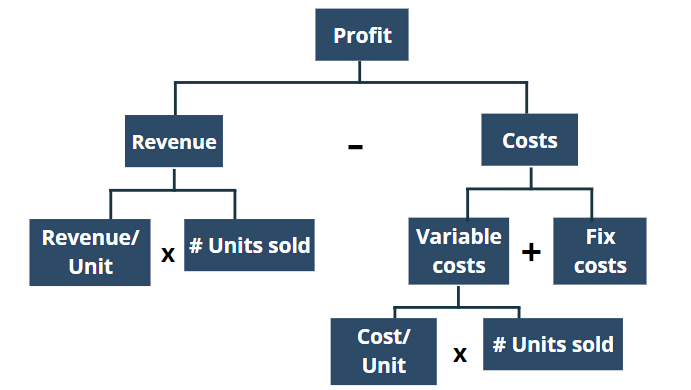
Now you can start with one of the branches. Let's take the revenue side.
3. Analyze the revenue side
Whenever you get the information that something has changed: quantify it! Ask by how much and in what time period . And very importantly: SEGMENT the revenue streams! You can ask the interviewer whether you can segment the revenues into its component parts. If the interviewer prompts you to do the segmentation, you can think about different customer segments (small business / large business, etc., age group, sex, etc…), product lines, or regions (South America, Asia, etc.). This segmentation will help you isolate the root of the problem. You'll be able to develop better and more targeted analyzes.
For example, when helping a chewing gum manufacturer improve his profitability, you may ask: “What are the revenue sources?”. The interviewer tells you that all revenue comes from two products: Flavored and non-flavored chewing gums. At this point, you might want to know the development of sales over the past couple of years. “How have sales figures developed over the years for both products?” He shares the following diagram with you:
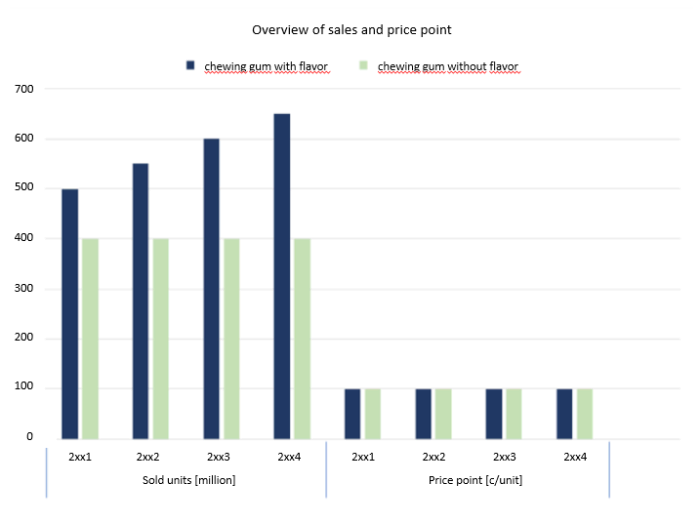
It now becomes clear that revenue is not the problem because it has grown steadily in recent years. Therefore, it must be costs that rose significantly, leading to a drop in profitability.
If you’ve found the biggest driver of the problem, you oftentimes have to switch to a more qualitative framework like the 4 Cs to find the underlying root cause! For example: when you have less revenue, but the price is the same and units sold dropped, you have to find out why. Is there a new competitor on the market? Do you have quality problems , or did you just stop a marketing initiative that you ran for years prior to this drop?
4. Analyze the cost side
Now explore the cost side. You know that costs can be broken down into direct and indirect costs . You can then inquire about the breakdown of costs: "Please tell me about the direct/indirect cost split for the products.” The interviewer hands you the following graph:
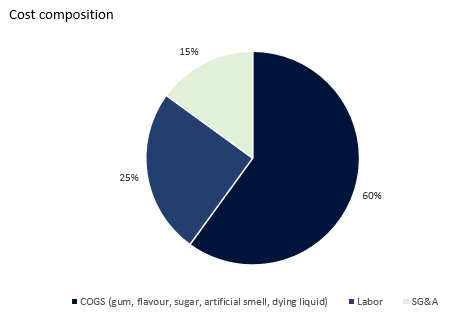
As we know that there are two different product lines, it is advisable to calculate their margins to check if there is a more profitable product line. You calculate the margin for both products based on the following formula:

“I'd like to calculate the margins for both products; do you have information on the different prices and costs for each of them?” The interviewer hands you the following graph:
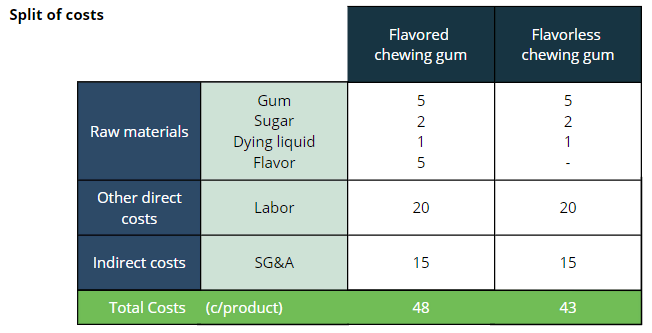
Based on this, you calculate the margins:
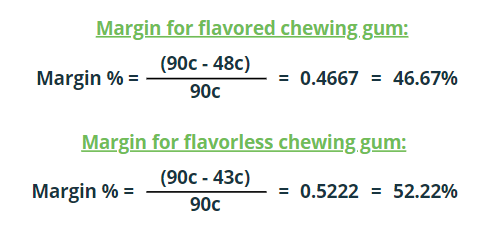
5. Close the profitability case
“Analyzes show that the product whose sales have increased (flavored chewing gum) is also the one with lower margins due to the added flavor. Therefore, total profit margins have decreased while sales have increased.”
After you have determined the root cause, you must develop a good logical solution (e.g., developing a competitive response , starting a marketing initiative, etc.)
It is important to stay structured even if you think you have reached the final stage. Therefore, categorize your approaches, for instance by short-term/easy to implement solutions and long-term ones.
- Negotiate with current suppliers.
- Look for other suppliers (form partnerships or buy greater amounts with batch discounts).
- Vertical integration.
- Release new products with better margins (e.g., low-calorie flavor gum or tooth cleaning gum).
- The client could also increase the price of the flavored gum, risking decreasing sales if customers do not see any added value with the price rise (high price sensitivity ).
1. MBB Final Round Case – Non-Profit Museum Revenue Increase
Style: Interviewer-led (McKinsey style)
Topics: Pricing , Profitability analysis
Your client is ‘Muse 19’ , a Museum in Paris with a large collection of 19th-century artifacts, predominantly paintings, and sculptures. The museum is run by a non-profit organization based in France. The museum is quite popular amongst students, artists, and tourists. Last year, the museum attracted almost 2 million visitors. Despite this, the museum’s revenue has been declining for the last three years. Surprisingly, other museums of similar nature have been doing much better than Muse 19. The museum director has approached you for advice. Read the whole profitability case .
2. Caribbean Island – MBB Final Round
Style: Candidate-led (usual style)
Topics: Brain teaser , Market sizing , Profitability analysis , Valuation
A wealthy client has recently bought an island in the Caribbean . She has engaged us to identify possible uses for her new island. Read the whole case .
3. Incos Pens
Topics: Market entry , Market sizing , Profitability analysis
Incos is a global manufacturer of writing products with divisions in North America, Europe, and South-East Asia. Their global sales are $60 m and their profits amounted to around $30 m . Their European division who manufactures and sells disposable pens is experiencing flattening sales and a decreasing profit. The client hired you to help him come up with suggestions to get profits back on track. Read the whole case .
4. Espresso, Whatelse?
Topics: Market analysis , Operations strategy , Pricing , Profitability analysis
Espresso Whatelse is an Italian company that produces coffee and espresso machines since 1908. It is the Italian market leader and has a strong presence overall in Europe. In 2019, Espresso Whatelse has increased its revenues, but it has seen declining profit margin . Your client wants to understand the root causes of this 2019 trend and how to increase its profit margin again. Read the whole case .
5. DHL Consulting case: Books & Codes
Topics: Operations strategy , Profitability analysis
A friend of yours recently got promoted to the position of director of a university library . Yesterday, your friend received a call from the Ministry of Education, who offered him to be part of a national RFID pilot with his library. As your friend is unsure if he should pursue this option, he asks you for your advice. Your task is to assess the RFID technology for his library. How would you approach such a request? Read the whole case .
Key takeaways
Profitability problems are frequent in consulting case interviews. To solve a profitability problem:
- find the root cause using the profit formula
- use a tree structure
- go down one branch at a time and segment it
- quantify and look for trends
- locate the biggest driver
- find out why through qualitative analysis and additional analysis (e.g., using the 4 Cs Framework).
Questions on This Article
Excise tax to be dealt properly, elaborate on the total profit margin.
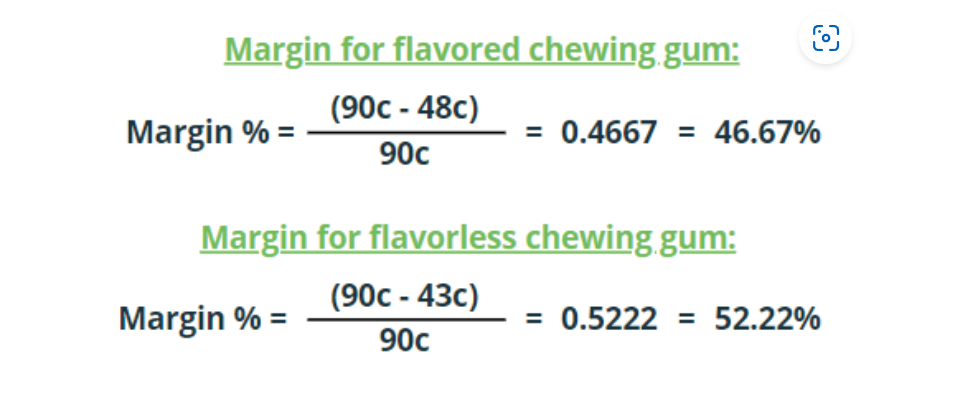
Related Cases

Bain Case: Old Winery

Oliver Wyman Case: Setting up a Wine Cellar
Oliver wyman case: on the right track.

zeb case: Quo vadis, customer?

EY-Parthenon Case: Virtual Marketplace

IMAGES
VIDEO
COMMENTS
Nonprofit Case Study Template. As you're drafting your first nonprofit case study, a template can help you frame the study in an easy-to-digest way. While you might decide to make a few tweaks as you go, we've found this template to be a great foundation. Provide Background Information. Paint a picture of your work and the community you ...
Adding images and infographics can make your piece more compelling and easier to understand. Remember to include other facts and stories to draw the attention of different donors. Here's how you should structure the perfect case statement for your nonprofit. 1. Start with your mission, imagery, and a tagline.
A great case statement will be clear, concise, and persuasive. Here are some tips for writing a great case statement: - Have an emotional opening: Start with an emotional story that will make your audience care about your nonprofit. - Explain the purpose of the organization: Make it clear what your nonprofit does and why it is important.
After creating a compelling story, begin designing your case for support. Your organization may have defined branding guidelines—if so, use them to ensure your case is recognizable and aligned with your organizational culture. If you have limited resources, designing your case for support can be challenging, but keep the following in mind.
Once we implemented the case study template, it took a while for people to use it. This is where constant encouragement from supervisors and managers can be quite effective, assuming they are sold on the value of this change first. One staff member took the time to fill out the template as best as she could by spending good time with the ...
What is a Case Study? Learn the basic definition of the case study and understand its meaning and relevance with examples… 2. Why is it important to write a Case Study? The usefulness of writing a case study…why is it important for NGOs to write a case study and how can case studies help in raising funds and building support for the NGOs… 3.
Less is more with a great case. Lastly, remember that the case is just a tool and should take a back seat to having a terrific conversation with the donor. Fundraising should strive for deep relationships. Many organizations waste way too much time in crafting the case when that time should be spent on donor research and securing meetings.
However, a basic template of a case study is useful for NGOs which they can work on further to present their point of view. Below. Link to the Main Page Case studies can be written in various styles and expert writers can always come out with new ideas on the format of a case study. However, a basic template of a case study is useful for NGOs ...
The Association of Fundraising Professionals defines "case" as: "Case, n. the reasons why an organization both needs and merits philanthropic support, usually by outlining the organization's programs, current needs, and plans.". You can write a case statement for a specific program or campaign, or for your organization as a whole.
We work with a lot of great nonprofit organizations. Here are our 5 most popular case studies.
The Sample Case for Support. Enter your e-mail address below to receive your sample case for support. It will be sent to you via e-mail immediately after you click the button. This case statement is for a fictional non-profit called The Montreal Children's Home. Please feel free to use this sample case for support as a template for your non ...
Although case studies have been discussed extensively in the literature, little has been written about the specific steps one may use to conduct case study research effectively (Gagnon, 2010; Hancock & Algozzine, 2016).Baskarada (2014) also emphasized the need to have a succinct guideline that can be practically followed as it is actually tough to execute a case study well in practice.
A case for support is a document put together by a nonprofit for prospective donors. The purpose of this document is to communicate what your organization does, the impact of your work, and most importantly, why a potential donor should support you. A case for support can also be referred to as a "case statement" or "donor prospectus ...
Find out more on Non-Profit/Public Sector/Non-Traditional Housing Core on the PrepLounge Consulting Q&A forum. Ask any questions about your management consultant career! ... Than you're drafting your first nonprofit case study, a template capacity help you frame the read in an easy-to-digest way. While you might resolve to make a few tweaks ...
Canva for Non-profits case studies. Discover how under resourced non-profit business deliver more value with Canva. "We've definitely seen increased numbers of engagement and retweets, having those nice, dynamic images has something to do with that.". Ashley Burke.
In fact, your non-profit can follow the same path I took with the organization mentioned above. Here's how we went about developing a solid, written fundraising plan to guide their development efforts over the following year: 1. Gather the Stakeholders. First, we gathered all of the key stakeholders at the non-profit across several different ...
Recommended Non-Profit Case Interview Resources Here are the resources we recommend to learn the most robust, effective case interview strategies in the least time-consuming way: Comprehensive Case Interview Course (our #1 recommendation): The only resource you need. Whether you have no business background, rusty math skills, or are short on ...
Our network of 700 business leaders and philanthropists is accomplishing far more together than by investing alone. We invest in changemakers that make a difference in their communities. Read case studies & success stories about our investments & nonprofit partnerships!
This case study describes the hopes and challenges faced by incorporating the mission center as a low-profit limited liability corporation (L3C). Aids Resource Center Ohio is the largest AIDS service organization in the state of Ohio and has increased its sustainability significantly over the past few years by leveraging the power of social ...
Case Study Day. Purpose: group of ten university students will. examine an issue facing a nonprofit. organization and offer ideas and solutions. for the issue. Benefit to host sites: Receive access to innovation and creativity of young professionals who have studied nonprofit. management, have completed internships and/or are working in the ...
Below are sample case studies of few of our engagements : 1. Strategic Planning. Our client is a $0.5 Mil non-profit organization that provides camping experiences for underprivileged youth in the San Francisco Bay Area. SITUATION. Our client was at an organizational crossroads. The President of the organization was in the process of retiring ...
To solve a profitability problem: find the root cause using the profit formula. use a tree structure. go down one branch at a time and segment it. quantify and look for trends. locate the biggest driver. find out why through qualitative analysis and additional analysis (e.g., using the 4 Cs Framework).
Role: UX/UI Designer Duration: 1 week Process: Competitive Analysis, Content & IA Audit, Sitemap, Card Sort, User Survey & Prototype Tools: Optimal Workshop, Sketch For this project, I wanted to…